Quaerere Verum
Contents:
I. Our current predicament
II. Universities in England and PHE: Big Business and National Politics in Local Areas
III. Operational Failures – HOW?
IV. What happened at the start of term? – A somewhat hypothetical retrospective
V. Underpinning Rationales – WHY?
VI. Concluding Remarks – A Second National Lockdown. What now?
I. Our current predicament
On the 13th of October, the leader of the Opposition, Keir Starmer, called on the government and the PM to follow the scientific advice of SAGE from the 21st of September 2020 and impose a national “circuit breaker” lockdown of at least two weeks. The next day, from opposite public-health perspectives, both Paul Goodman of the Conservative Home and Anthony Costello of the Independent SAGE critiqued Starmer’s announcement in ways that almost involuntarily converge to depict England’s current predicament: How can a country fight Coronavirus without a viable system of testing, tracing and isolating the virus, and without lockdowns?
To be concise, both Goodman and Costello started their critiques with the same question: how could a “circuit breaker” alone resolve the problem, unless the testing, tracing and isolation system was also massively and urgently reformed?
For Goodman, the test and trace scheme is lacking so much in capacity that it could never be reformed quickly, meaning the “circuit breaker would have to be switched on for the duration” effectively becoming “a full national lockdown of uncertain length” that would damage the economy even more and not stop the virus – a solution he finds entirely unacceptable. According to Goodman, Starmer knows this very fact but has sensed that the government has lost control of the Coronavirus and is only asking for a “circuit breaker” now in order to expose the PM and build on polling support for lockdowns. It is important to note here, that even for Goodman, the “circuit breaker” has an air of inevitability to it.
This is so, because, although he does not mention it, he must know, that like in the first wave, the current exponential growth in cases, and then in deaths, will soon be at a critical level once again. In other words, that Starmer is not just sensing that the PM has lost control of Coronavirus, but that he is scientifically assured that this has happened. That the same governmental delay that cost us so many lives during the first wave is occurring again, but amidst a second wave of the government’s own making. Looking at these two next charts, it is so easy to see why SAGE had requested a circuit-breaker on the 21st of September (a day and week of great importance in the opening of the Universities), why Starmer has requested one on the 13th of October, and why the Independent SAGE has asked for one on the 23rd of October:
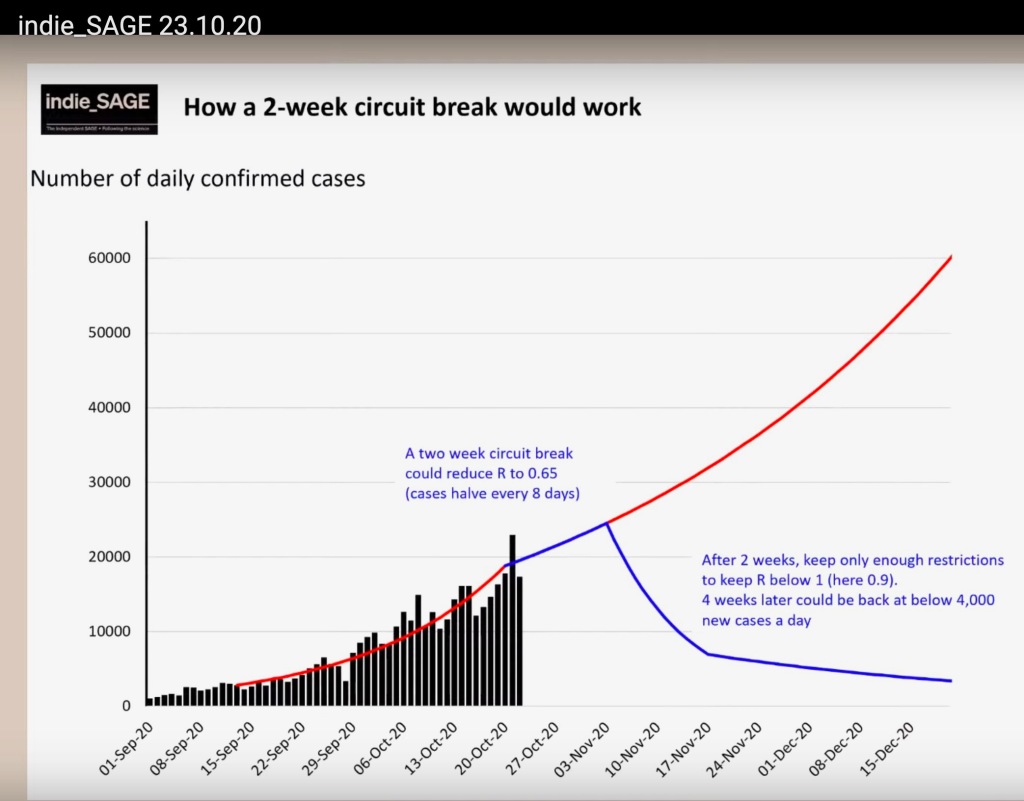
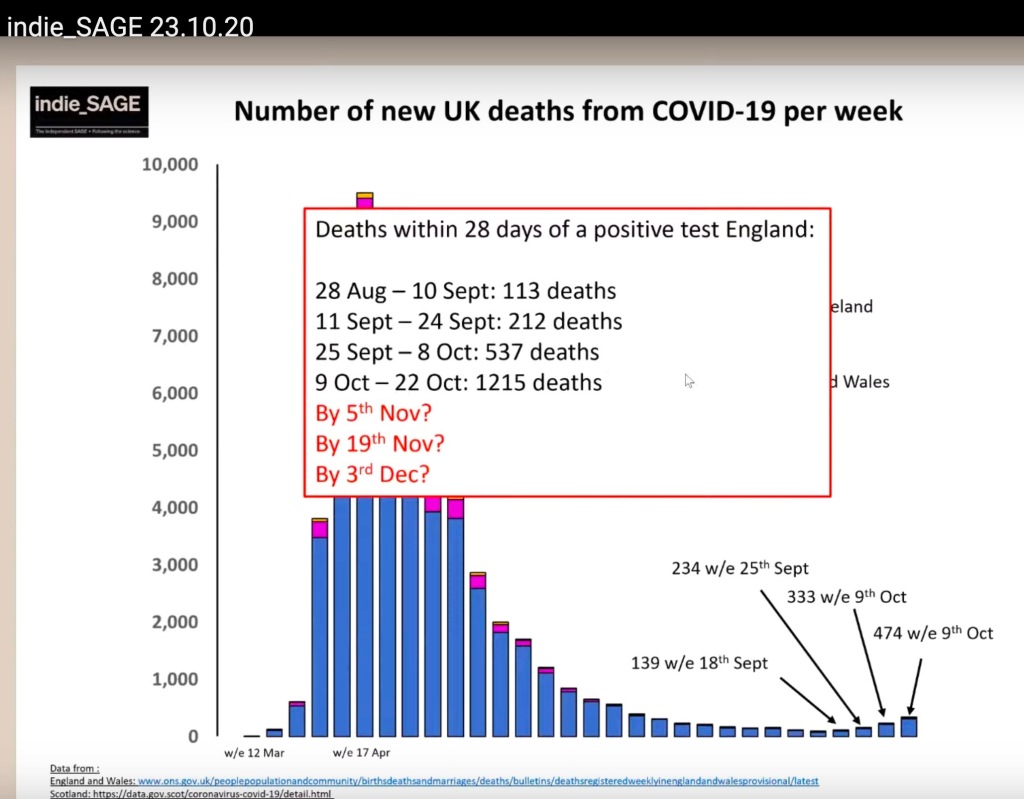
The important thing to also understand about these two charts is that the argument of both SAGE and the Independent SAGE is that the Three-Tier system of the PM (active from the 15th of October) will decrease somewhat the numbers but not do enough to arrest their exponential growth. We could thus argue that the PM and the Conservative government and party have opted to go against the government’s scientific advice, while the Welsh (circuit-breaker from the 23rd of October), Northern Irish (national circuit-breaker but with less restrictions than Wales, from the 16th of October) and Scottish (a Five-Tier system where Level 4 is similar to a full lockdown, to be implemented from the 2nd of November; but after having already introduced temporary restrictions on the 8th of October) governments have generally gone with it, although with variations. This means that possibly by the end of November and, quite surely by the end of December, we will likely have plenty of hard data regarding the effects of the four different systems, and of how important, or not, it would have been to follow the advice from SAGE and the Independent SAGE at the right time.
It can already be seen from a chart released by SAGE on the 30th of October that the English tier system has not had the effect the government has hoped for over more than two weeks, while NI and Scotland have done much better already, with the effects for Wales yet to show during or after next week.
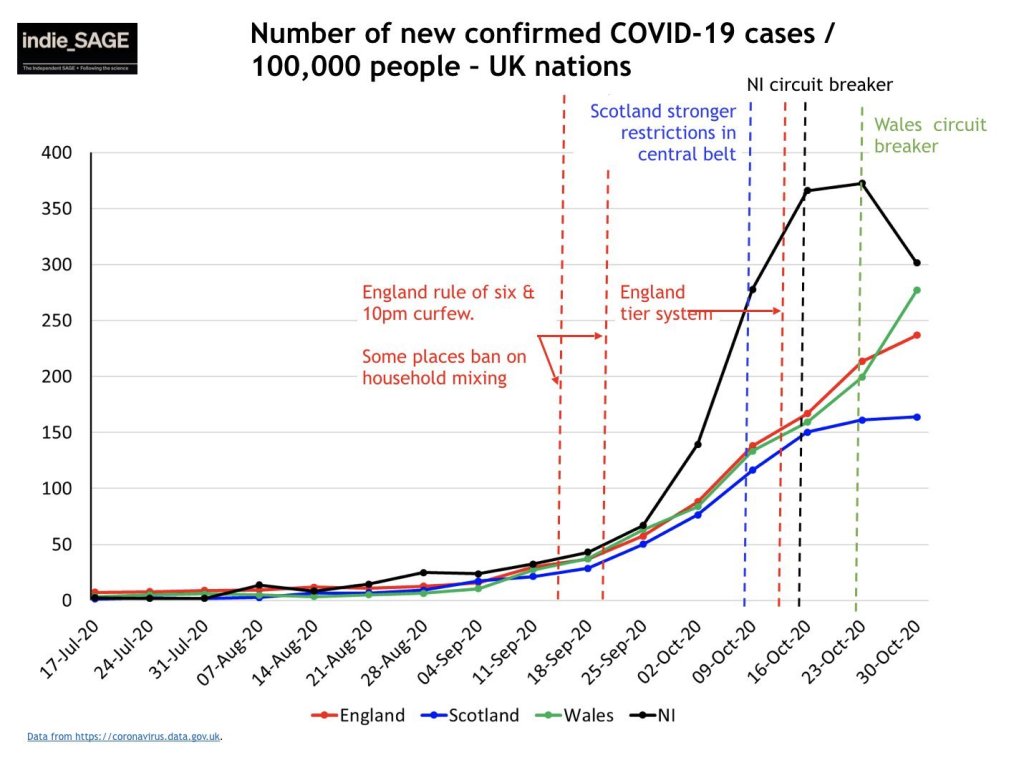
(Source: here)
These charts also explain Costello’s argument. “A national lockdown is a last resort and an admission of failure”, he admits. However, in his view, “delaying restrictions would allow the virus to spread and cause greater economic damage in the long term” as well as loss of lives. Costello then decries the failed opportunity to build a viable test and trace scheme in the time afforded by the previous national lockdown and suggests measures that could be taken now – 23/10/2020:
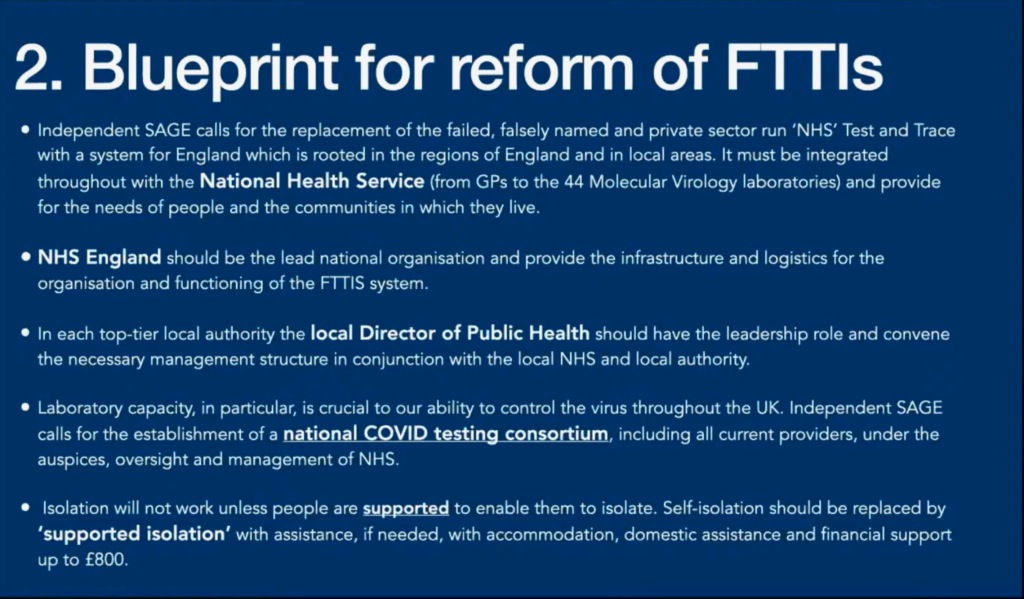
The problem, which he does not address, is that while an extended “circuit breaker” could lower transmission of the virus for about two to three months, it is not at all clear that the existing test, trace and isolate system could be reformed in such a short period of time. If a viable testing, tracing and isolating system implies a move away from centralization to decentralization, from privatization to being a central part of the public health system, and from massive investment in private companies to massive investment in GP practices and the NHS (options to which this government seems most categorically opposed) then it is highly unlikely that such reforms could be undertaken in less than six to eight months. While Sir David King from the Independent SAGE argues that the test and trace system could be reformed to fully operate locally in a record time of about 4 to 6 weeks, a more pragmatic view would suggest that the government would need a similar amount of time just to find an agreement about how to reform the existing system. And this is all before the phases of planning and implementation when we must factor in the complex and time-consuming administrative overhaul effectively equivalent with the reorganization of both the NHS and of Public Health England, and of their current leadership.
A more interesting proposal (but in my opinion, we are still grasping in the unknown for what could work for the UK in the medium to long-term) is that of “a coordinated circuit breaker followed by intermittent and contingent ‘reset’ periods” that “could avoid a longer lockdown, help the economy, keep a handle on COVID, and save lives.” However, this would require a commonly shared understanding of the virus that transcends ideological and political divides, and an unparalleled unity of vision and trust between local populations, scientists and the different levels of government, coupled with absolute and verifiable transparency concerning daily data about the virus. Movement towards such a shared vision cannot happen without the realization that the lockdown vs. economic growth opposition is likely a false dichotomy, inasmuch as those countries which managed to control the virus, managed to protect both a considerable number of lives and their own economies, while those that did not, usually suffered the most economic pain and the greatest loss of life (according to the FT):
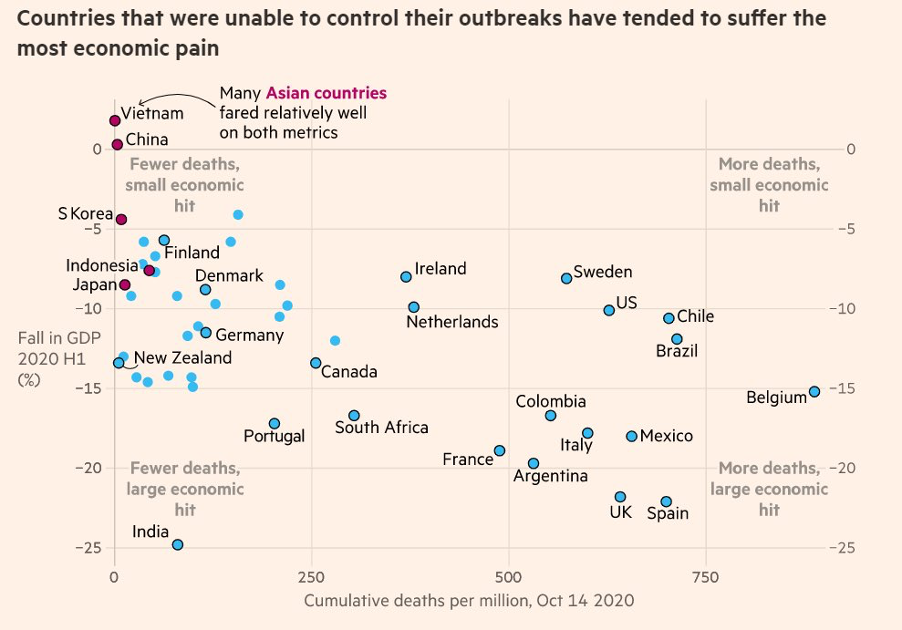
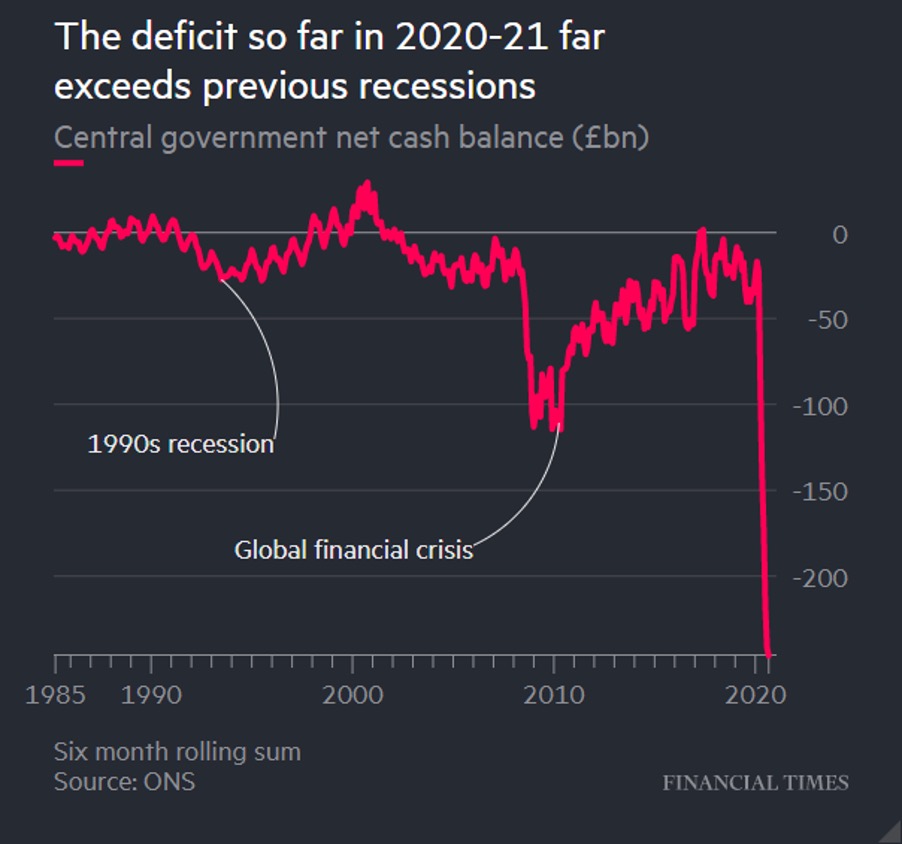
It would seem then, that England is caught in a catch-22 scenario that could wreck the economy (either allow virus transmission to move towards exponential growth, which would severely impact the economy, or intervene through economically devastating national and local lockdowns), being punished for having failed to build its test and trace system during the first period of national lockdown.
Nevertheless, while the urgent reform of the testing, tracing and isolating system is clearly essential to any type of solution to the pandemic, and the more pragmatic hope here would be that a mix of public-private solutions could deliver the needed capacity in less than two or three months, neither the test and trace scheme, nor the tool of lockdowns, can, alone or together, contain the coronavirus crisis. The answer can never be just a technical solution like massive testing (or a vaccine, or anything else for that matter), something Paul Goodman fails to realize in his somewhat utopian espousal of the government’s proposed “moonshot”.
None of these instruments can function if our social and economic institutions do not adhere to (and in fact, creatively devise) basic public health prevention strategies, admitting the need to reform themselves, many times at a financial loss, in order to protect the cities and communities around them. Similarly, such institutions cannot hope to implement novel and creative public health prevention strategies if they do not tackle the ideological polarization and misinformation present within their very own communities regarding Coronavirus. Most importantly, however, without open inquiries into how outbreaks start, and without transparency in reporting them, our social institutions, far from protecting our lives and the economy, will only act as massive conduits for transmitting the virus to the largely unaware communities inside and outside of them.
While it is important to stop the fires raging, it is equally important to not set new fires ablaze.
II. Universities in England and PHE: Big Business and National Politics in Local Areas
It is at this point that we have to talk about universities in England, as it is these that are at the heart of the new wave of Coronavirus cases that started in September and gained intensity and spread during the early part of October. Although no overall data has been released by the government or the Office for Students, the shocking rise in the number of cases in specific city areas clearly identified as representing areas of student accommodation (and in the span of only a week or two from the start of the term), leave little room for doubt:
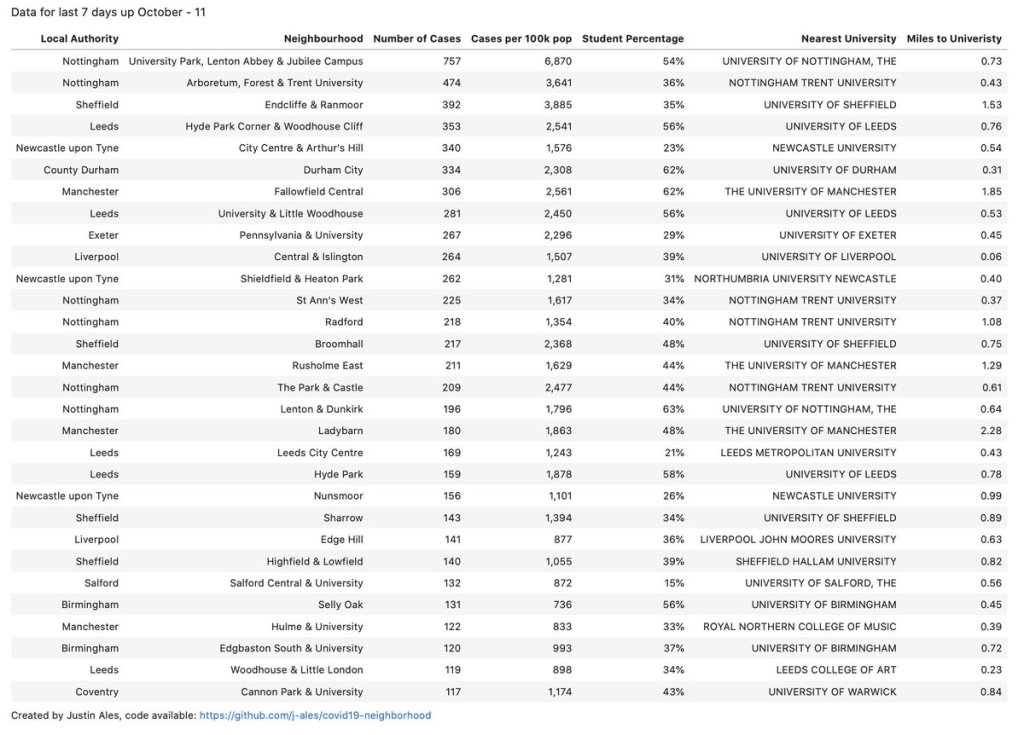
This is a chart that the Independent SAGE had used on the 23rd of October as an example of how almost all those wards that had seen big spikes since September are in student residence or university campus areas:
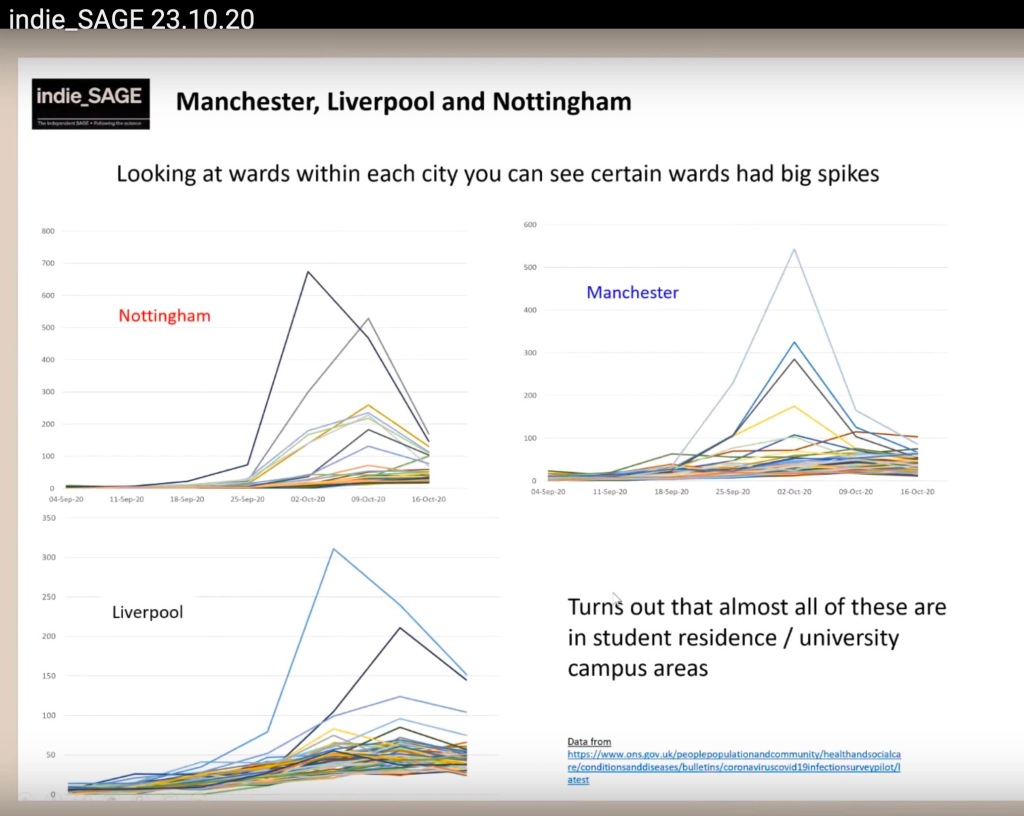
That the highest numbers of cases in England have generally appeared in those cities hosting two large-size universities (the exception to the rule apparently being London) points to a similar explanation.
The following chart from the FT shows quite clearly that, after the start of term, local areas with a university have seen much higher numbers of cases than local areas without a university:
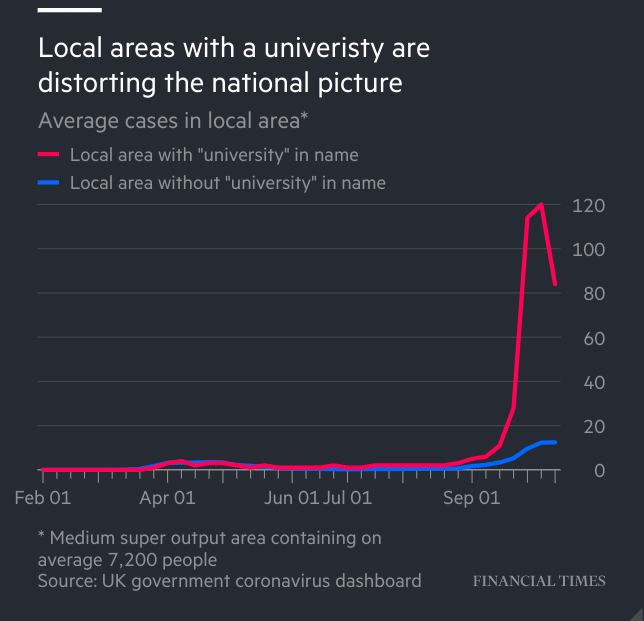
A similar chart, but with more specific information about student populated neighbourhoods, confirms the information above:
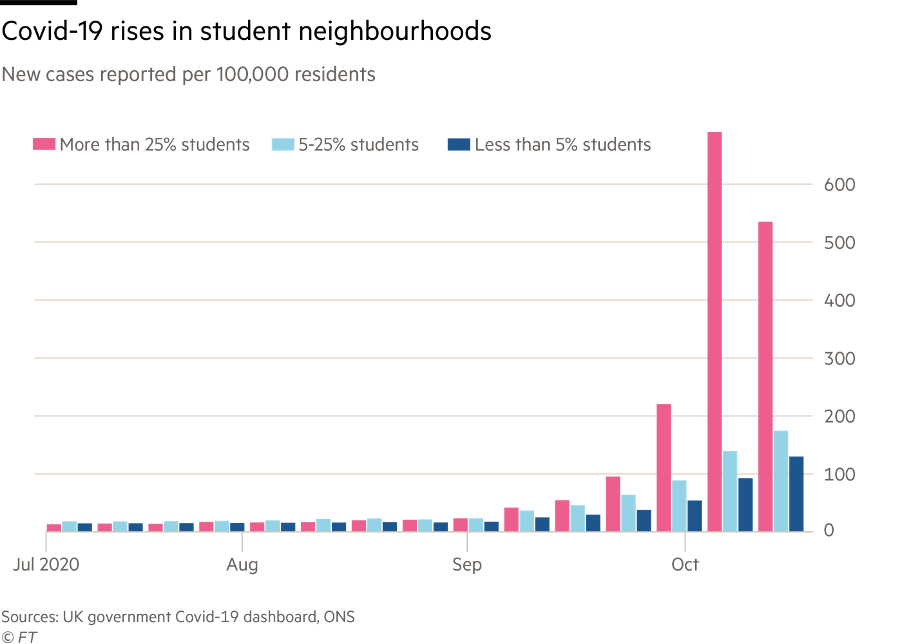
A more recent chart, from the 23rd of October, shows how the rise in Covid-19 cases coincided with the opening of schools and its explosive rise with the opening of universities:
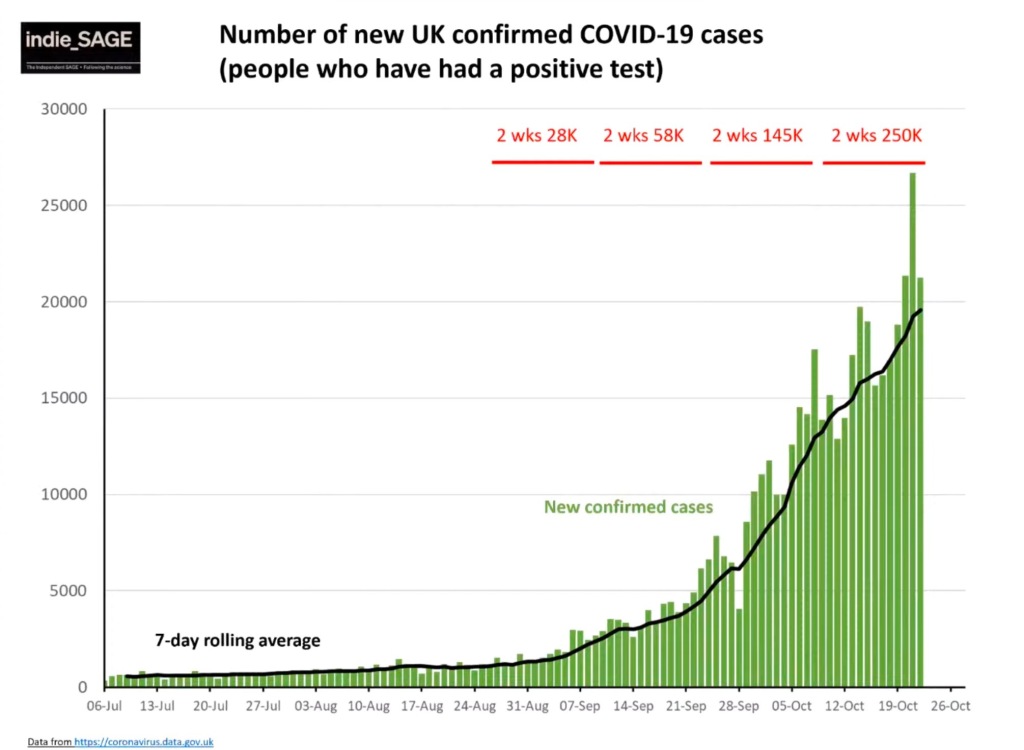
In another chart, released by England’s deputy chief medical officer Jonathan Van-Tam on the 12th of October, we can see how, from late September to the middle of October, most of the rise in cases nationally had been in the ages 16-29.
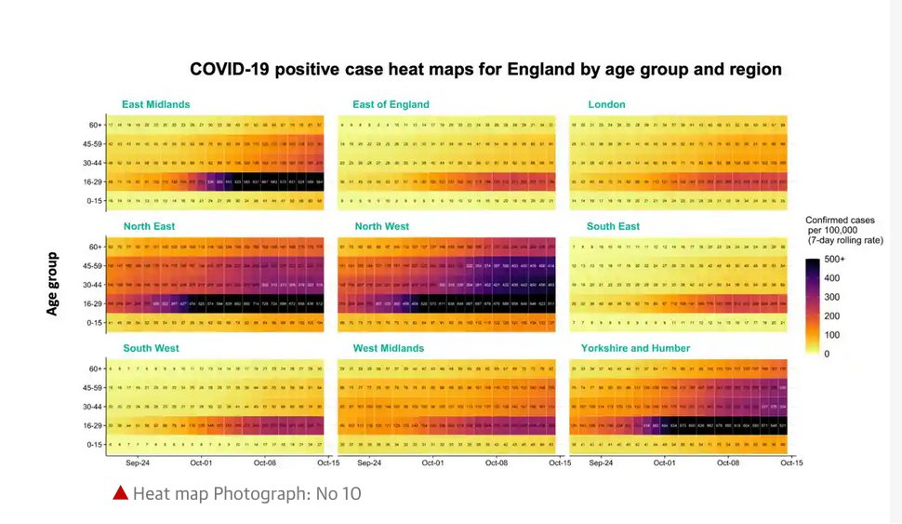
And yet another chart shows us how the numbers of Covid-19 hospitalizations has started rising in all age groups precisely from the start of term in schools and Universities, with numbers multiplying week after week:
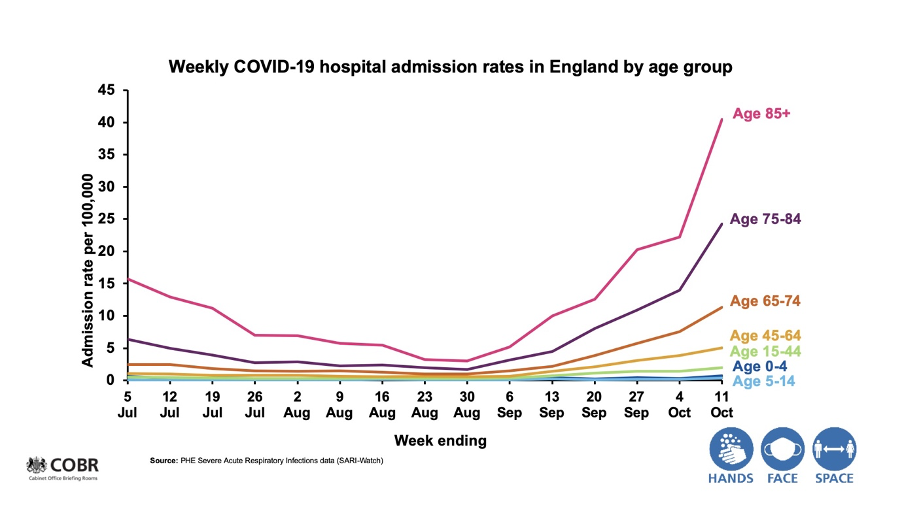
The rise and subsequent increases in ICU/HDU admissions rates in England in ages 45-84 can be similarly matched with the start of term in schools and universities:
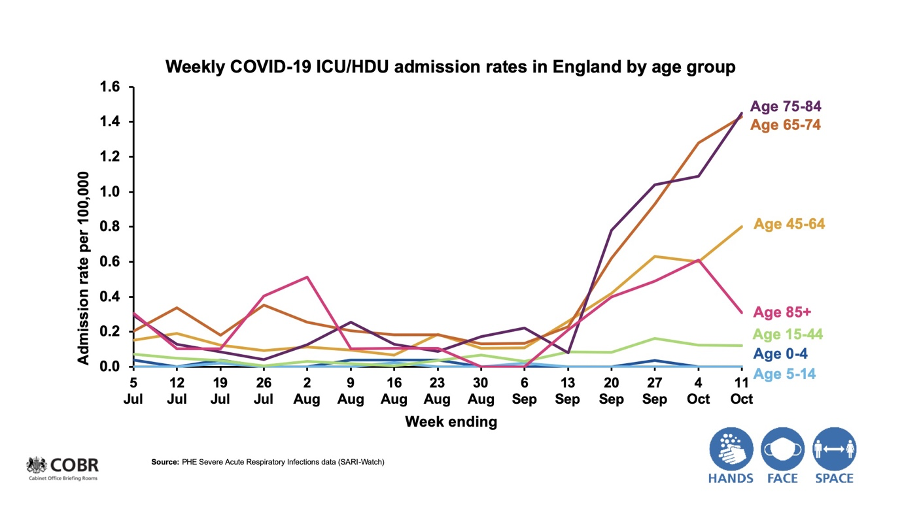
Unlike Scotland, where universities generally began their term a week or so earlier, most universities in England commenced their term on the 21st of September, for freshers, and on the 28th of September, for returners (second and third year undergraduate students plus postgraduate students), with their teaching starting on the 5th of October (The University of Oxford is one exception here, with their start of term scheduled only for the 11th of October).
Nothing is clear cut with universities, as some student cohorts arrive earlier and some later. However, it can be assumed that freshers arrived in their accommodation during the first two weeks prior to term, meaning between the 7th and the 14th of September (with some arriving even one week earlier), with most of the returners arriving between the 14th and the 21st of September (and some the week after).
Although the reporting of Covid-19 cases by different universities does not seem to be entirely transparent (and a considerable proportion of NHS test results might have been delayed by a week to 9 days) the ‘Timeline of cases by institution’ UCU graph is useful in showing that most of the first big rise in Covid-19 cases at English universities so far has been reported between the 28th of September and the 12th of October. Considering the delays in returning Pillar 2 test results and how difficult booking a test with the NHS has been during the same period, that freshers would not have been exactly prepared and willing to book a test, and that the incubation period for Covid-19 is set at 1-14 days (with an average incubation period of 5 days), we can only infer that students became infected with the virus almost immediately upon arriving in their accommodation. How can that be, considering all the preparations, assurances and advertising the universities have done in order to create a Covid-19 free environment?
On the 23rd of September, Professor of Global Health at the University of Edinburgh and Scottish Government adviser Devi Sridhar announced publicly on Twitter:
“Scotland now having significant outbreaks & large clusters within universities since they re-opened last week.”
Exactly the same can be said now about universities in England, or rather, exactly the same should have been publicly said around the 28th of September, a week after most English universities had officially opened on the 21st of September. It is no coincidence in my view that SAGE had recommended a circuit-breaker on exactly the 21st of September, with the additional intervention: “All university and college teaching to be online unless absolutely essential.” (An interesting aside fact – the numbers of positive Covid-19 cases in sizeable Scottish universities with large campuses have been considerably and consistently lower than those at English universities, if we look at the ‘Timeline of cases by institution’ UCU graph).
Notice that no national, regional or local Public Health England authority, from the many keeping daily oversight over the re-opening of universities (re-opening proceeding according to plans they have been supervising since July), has issued any similar statement. I am referring here, in particular, to the Director of Public Health in any given local authority, together with the PHE health protection teams – the local/regional part of PHE tasked with making risk assessments, continuous monitoring of available data, identifying transmission, defining, controlling and managing outbreaks and reducing transmission, and, also essentially, with informing the local authorities (county, district, borough and city councils) and the general public about the timing, location and number of Covid-19 cases.
Instead, it took more than 2-3 weeks for some of the Directors of Public Health in different local authorities to even admit some kind of ‘controllable’ outbreak was present in their local universities, and this only happened after repeated statements that the outbreak is “among the general population,” and that cases are “rising everywhere in the county” or “in all districts.” And when they did admit to the fact, they did so in a veiled manner, either by stating that the data shows that “higher infection rates are now being seen in young people aged 16 to 24” or by offering assurances that there is no evidence of wider community transmission. Considering that by the 28th of September it had become obvious to both universities and PHE that potentially massive Covid-19 outbreaks were underway on campuses at 45 universities it is remarkable that on the 29th of September Sky News could report the following:
“Some universities have been told not to release the number of cases by public health officials.
A spokesperson for the University of Nottingham told Sky News: “Regional Public Health England is currently asking us not to release institutional data for a couple of reasons – they are keen not to confuse their formal weekly data releases but they are also mindful of undermining the message that in the East Midlands, COVID-19 is affecting all demographics and so all demographics should have responsibility to protect health and follow the rules.
We are continuing to press the argument to PHE that we should be able to release data.”
Even stranger here is the widely reported IT failure that managed to lose track of 15,841 Covid-19 positive cases (considered “non-complex cases,” that is, cases that were tested in community settings, rather than in hospitals or care homes – so presumably, also in university settings) between the 25th of September and the 2nd of October – period coinciding precisely with the week in which the first huge rises in positive cases of Covid-19 would have been observed at English universities but also with the days and weeks after SAGE had advised for the introduction of a circuit breaker lockdown. The fact that the Health Secretary Matt Hancock later told MPs that “outbreak control in care homes, schools and hospitals had not been directly affected, as they do not rely on the data in question” should make us wonder if the lost data did not in fact concern UK universities. For the week after, from the 5th to the 11th of October, the government would later report 9,000 cases of Covid-19 amongst students in the UK, with the numbers spread between 68 campuses across the country. Less than a week later from that, on the 17th of October, the UCU dashboard reported 20,172 cases of Covid-19 in UK higher education, while UniCovid UK “put[] the number of confirmed cases for students at 20,782, for staff 333, in total 21,115,” with 115 universities reporting such cases (93 in England, 1 in Northern Ireland, 14 in Scotland and 7 in Wales). Also on the same day, The Guardian reported the following, a snapshot of the state of affairs that had generally characterized early responses of English universities in the week from the 21st of September to the 28th of September, before resulting in them developing massive outbreaks: “A lecturer at Bournemouth University, who wants to be anonymous, is angry that the university has not made its Covid numbers public. ‘Every single student hall at Bournemouth has cases, from a single isolation, to a whole corridor. There are more than 100 cases but the management thinks this should be kept confidential.’”
It is exactly such instances of delay, silence and obfuscation from both PHE and universities (and one must count here the week/s in which the number of cases were low but many cases of isolation existed, and the prior weeks in which knowledge of patterns of socialization that would greatly spread the virus had been widely observable) that is responsible for the transmission of the outbreak in many other parts of the wider community. After having waited for several weeks of widespread transmission, one could indeed claim relatively unopposed that the outbreak is among the general population and rising everywhere.
It is easy to see how such a course of action might have, quite comfortably and conveniently, excluded both universities and the government from any further scrutiny, with the focus of restrictions being placed instead onto the working class, local communities and businesses, and places such as pubs, bars and restaurants, a public scandal now diverting attention even further away. (This is not to deny that places such as pubs, bars and restaurants were probably an important secondary transmission avenue for university outbreaks reaching the wider community, but can anybody truly say they were the ground zero and the primary sources for these latest mass outbreaks in the country?)
This silence or misdirection points to another question asked in every city or region that has seen a sharp outbreak of Coronavirus in the period 21st September to the 10th of October, but which almost no one seeks to answer: where did the local outbreak originate? Where is the origin of the outbreak? Where did the transmission spread from? What has caused this potential second wave?
That local newspapers and local councils did not seek an answer to this question testifies both to the political influence of the Directors of Public Health and of PHE and to the amazing influence of powerful universities on local mass-media and local councils. It is this power dimension of universities as both state-agents and private commercial entities that, in many cases, cannot be held accountable by any city, local or regional authorities, that is undertheorized and naively overlooked. The role of private accommodation providers accounting for half of student bed spaces in the UK based on 2018 research by Unipol and the National Union of Students (NUS) also needs more scrutiny.[1]
[1] It might well be that in some cities PHE, the local authorities (and/or some of the key local businesses) and universities had commonly agreed, even before the start of term, that students were too important for the local economy to let anything impede their arrival and stay on campus and in the city, although the contestations and surprise of local city councillors during the outbreaks generally show otherwise. Even in the case of such a possibility, however, the clear and almost wilful ignorance by universities and PHE of the most basic public health guidelines (to be discussed below), their joined actions to delay the news becoming public and their failure to properly address the root causes of outbreaks would have put the health of both the university community and of larger local communities at risk, while also heavily impacting on the local economy (because of the very probable later imposition of measures such as a tier 2 or 3 lockdown or a local circuit breaker). When considered in terms of their impact at national scale, such actions would have been exponentially riskier and massively self-defeating, because of the threat of a nation-wide second wave like the one experienced in April, with all the effects associated with it. While such actions would have been an affront to the very notion of efficiency at both the economic and political level (bringing a huge cost to both the university and to the government), a massive undermining of democracy, and a most vile threat to the health of the general public, it cannot be said, however, that more important private interests amongst the higher levels of the university and of the private accommodation sector, as well as more significant political interests of the national government, would not have been safeguarded, through the very same measures, in the short term.
That presumably the University of Exeter has publicly confirmed that “more than 80% of coronavirus cases in one of the worst affected cities [namely, Exeter] are attributable to students,” is spectacularly unique, though less surprising now, considering the more recent need to counter a potential lockdown by emphasizing that any major outbreak is localized and could be contained.
As far as I am aware, the first article to really look at this question appeared in The Times (a daily national newspaper) on the 9th of October, and was written by Data Journalist Ryan Watts and edited by Chris Smyth. The article did not seek to identify the origin of the second wave of Coronavirus, but suggested that “universities are amplifying the epidemic” and established that “of the 20 areas with the highest infection rates, 11 were student neighbourhoods” (in Manchester, Leeds, Newcastle, Sheffield, Nottingham and Liverpool, etc.) and 6 others, student heavy areas (Nottingham and Manchester, etc.). This analysis was based on data about the entire population that tested positive for the virus in the week to October 2. Its conclusion was measured but poignant: “Most of the areas with the highest infection rates in recent weeks are dominated by students, raising questions about how the return to campus has been managed.”
In the same article, the secretary of the University and College Union, Jo Grady, who had warned about such dangers on the 29th of August , 31st of August, and on the 14th -17th of September, was also cited as stating that the recent ‘spikes’ were “a predictable and preventable crisis that ministers and universities chose not to do more to constrain.” As far as I am aware the first time an explicit link was made between England’s rise in Coronavirus cases and the start of term at Universities in England was in the FT on the 22nd of October (a month later from the official start of term, time throughout which the virus had been spreading mostly unhindered), through the chart below:
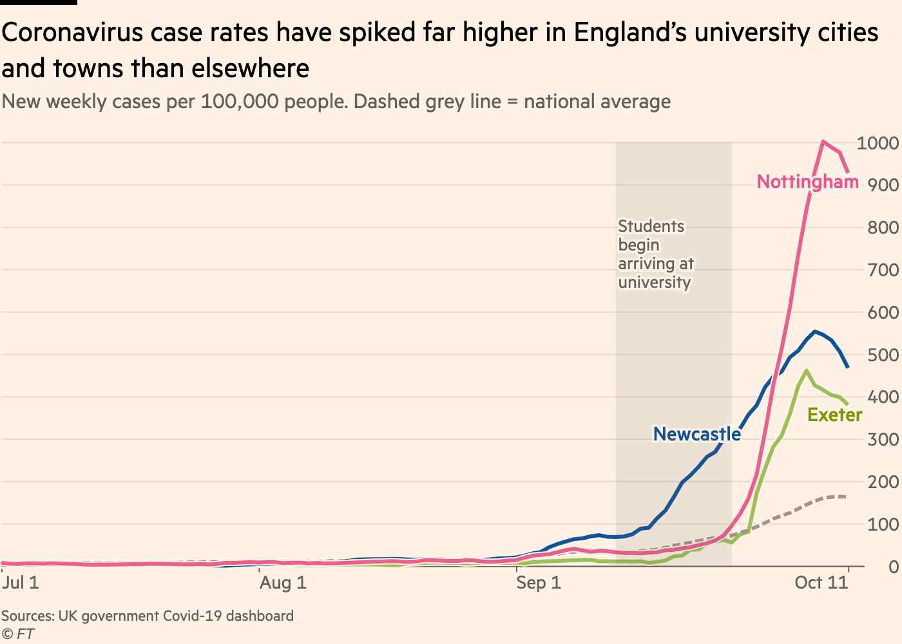
It is quite widely known now that in-depth and specific warnings about the rise of Covid-19 in UK universities, and about the measures needed to prevent them, had been offered earlier not only by the UCU and the Independent SAGE, but also by Gavin Yamey in the British Medical Journal. In addition to these, the 21st of September advice from the SAGE urging ministers to impose “a circuit breaker lockdown,” have everybody work from home where possible, and move all university and college teaching online, has also been and continues to be largely ignored by both the government and a large number of universities with very high or substantial numbers of Covid-19 cases.
How can it be, then, that the partnerships between PHE and English universities led to mass outbreaks developing so quickly and in so many university campuses at the very start of term?
This is the question around which any current analysis of the current higher education system in England must revolve. While the topic of the post-pandemic university is one admirably covered in the academic community and which could have many facets and bear many fruits into the long-term future, I would suggest that ‘the pandemic university,’ meaning, research into the Covid-19 crisis now unfolding in English universities, should maybe be given priority for the time being. Until that time, I can only emphasize certain major operational failures and their probable underpinning rationales as the reasons why so many English universities have failed to prevent Covid-19 mass outbreaks and are now failing to stop their transmission into the wider community.
III. Operational Failures
III.1. Centralization, financialization, and the drive for efficiency in University Halls of Residence over a period of ten years
Until the late 2000s most universities still displayed a form of organization for their student halls that was reminiscent, though not identical, with the structure of the Residential College developed by Durham University in the 19th century. The Durham model of the Residential College deviated from the models of Oxford and Cambridge by creating colleges that were only residential, but which, despite some degree of autonomy, functioned under the central administration. In the Oxbridge model, colleges had been both residential and teaching institutions with considerable legal autonomy and independence from the University. In today’s terms, the Oxbridge model saw student accommodation (or the student halls) as the natural extension of the academic divisions and their specific academic departments, with residential colleges “ultimately responsible for selecting and admitting their undergraduate students” and offering tutorial teaching for undergraduates. In the Oxbridge system one can still choose their residential college based on the courses available for that college, which is obviously not how we think of student accommodation nowadays. Educationally, this model made a lot of sense because it integrated academic life with all aspects of student life, by drawing the undergraduate students closer to the postgraduate students and to the junior and senior academics in the same fields, thus creating a truly academic community [of course, in such a set-up senior academics would have held an enormous amount of influence (both positive and negative) compared to their influence in most universities today].
The Durham model continued this same model by severing most of the links between Faculties or Departments and the Residential College and bringing the student halls under the control of the central administration. In semblance, administrative organization, pomp and rituals, however, the Durham college retained the same model: “Each of the Durham colleges has the standard configuration: a master or principal at the head, a senior tutor who is responsible for advising and welfare, a body of senior members (fellows and tutors), and a body of junior members (undergraduates and graduate students). A complete compliment of supporting facilities is present in each college: offices and reception space, a senior common room for the fellows and tutors, a junior common room–bar–game room combination, a library, and a spacious dining hall. One of the pleasures of touring the Durham colleges last month was seeing residential college buildings that were designed by people who understood the collegiate idea. The placement of offices, the landscaping of the courtyards, the configuration of the dining halls and common rooms—all these things bespoke a deep understanding of how architecture supports communal life.”
The Durham residential college model was also adopted in the late 1960s by the University of Kent, Lancaster University and the University of York. All other English universities copied the same model described in the quotation just above but eliminated the very notion of the residential college, and of its relative independence, and streamlined its organizational structure to fit with the demands and purview of central administration. The result of this process were the “University halls of residence” as we knew them prior to 2010 (that is, before the fall-out from the financial crisis of 2008).
Prior to 2010 the University Halls of Residence still retained an organizational structure reminiscent of the Durham (and indeed Oxbridge) collegiate model. Each Hall of Residence was run by a Warden (usually a Senior Lecturer) and a deputy Warden (usually a Junior Lecturer) assisted by a team of Senior Residents (postgraduate students in general, but usually PhD students, who could later become Wardens). In other universities, the titles differed but the scheme was similar: Wardens, Vice-Wardens (Senior Members or Senior tutors), and Resident tutors. Oftentimes Wardens served for more than ten years in their role (Vice-Wardens served for extended periods too), continuing a tradition many decades old, which means this organization system ensured those in key roles had considerable experience in pastoral roles, the organization of student life, welfare and disciplinary matters, and even some degree of say in related university policies. For each of the Halls, the Warden was assisted by a Secretary, a Hall Manager, an Assistant Manager, Porters, a catering/bar team and a cleaning team, etc. All the Hall administrative personnel worked very closely with the Security team at the University.
Since 2010 this organizational model for the University Halls of Residence has been under attack from several directions (although, it still continues to this day in some universities):
Model A.
Probably, the most widespread tendency has been to remove the roles of the Warden and Vice-Warden and maintain only a reduced number of Senior Residents, thus effectively removing the pastoral teams out of the halls. In the old system, and the new system has retained this feature, Senior Residents were available in shifts, with each of them available on duty for 24 hours (meaning, primarily responsible for the entire Hall at night-time) approximately one day per week, but only during term-time.
In the most radical version of this new system, the Senior Resident role, once only open to postgraduate students, became geared towards second and third-year undergraduate students (and away from PhD students), known as Residence or Resident Assistants/Advisors or as Residence Life Mentors. Referred to Residence Life Coordinators administrative staff at the university holding an undergraduate degree [“Education: Bachelor’s (Required)”] and few years of administrative experience, were then recruited to manage such teams.
While extremely popular, this version of the model did not apply everywhere the same way. One interesting variation, for example, is the University of Manchester, which developed a more complex structure in which ResLife Advisors (not Assistants), still recruited only from the ranks of postgraduate students or staff, were led by Res/Life Officers (one per Hall), with all of them headed by a ResLife Manager and a team of three ResLife Coordinators (though the Manager and Coordinators were still recruited from within the ranks of administrative staff holding an undergraduate degree) – an interesting set-up where staff with an undergraduate degree manage a team of postgraduate students. Another variation is Bristol, where the Wardens and Duty-Wardens were removed but where the role of Chief Residents was reserved generally for postgraduate students, with the role of Senior Residents geared towards second and third-year undergraduates, both of them reporting to a Residential Life Adviser coordinating a cluster of residences. In the Bristol system, all these roles are part-time. It is not clear what educational and administrative criteria a Residential Life Adviser must meet except for having “previous experience and qualifications in the provision of mental health and wellbeing support.”
Such a reorganization at Bristol University, it has been reported in 2017, would have been expected to “result in savings of £800,000.” It should be understood here, that since the Wardens and Vice-Wardens sat on a number of University Committees (including Hall Committees or Councils that included members of the University Council and Senate etc.), with Senior Residents from all Halls usually also having their own President and Senior Residents’ committee – this organizational change would have erased, in one single stroke, all those intermediate bodies and committees acting as a somewhat autonomous and more democratic interface between the students and academics and the central administration of the university. This, by the way, is the main reason why the majority of academics in many universities had no inkling of what was happening in University Student Halls at the start of term in relation to the Covid-19 pandemic, reason for which they were unable to foresee and raise specific concerns, issue specific warnings or hold anyone accountable, before the outbreaks had occurred, and sometimes, even in their aftermath.
We are, of course, not talking here only about making cuts and the removal of pastoral services out of the halls (or their almost complete erosion) but also about their centralization and financialization.
Centralization as the removal of any influence academic structures/academic identity might have had on student accommodation but also as the replacing of a relatively decentralized system in which each Hall had its own administration, with a top-down one, in which several Halls share a single Hall’s administration team directly affiliated with a centralized management authority, itself part of the central administration of the university.
Financialization, because of mainly four reasons:
1) because Hall managers newly employed from the private sector (usually hospitality) streamlined and centralized Hall services etc., by retaining a very small number of core workers (porters, cleaners, catering staff etc.), if at all, on reduced contracts, while relying on outsourcing (temporary work on zero-hours contracts) when faced with more demand.
2) because of the introduction of bonuses based on the amount of savings made to the budgets available to managers in Professional Services from top to bottom, meaning from the Registrar, to the Director for the Student Experience, to the Director of Residential Services and so forth, down to the Hall Manager (or down the different levels of similar organizational hierarchical structures);
3) because the role of Hall managers is not only to offer a service to students but to maximize profits by renting accommodation to companies and organizations outside of student term or whenever else possible;
4) because part of the student accommodation at Universities (usually the self-catered halls) has been privatized through outsourcing or private-public partnerships with private companies involved in both building and administering what is known as “purpose built student accommodation” (PBSA). Such properties usually take two forms:
An understanding of PBSA is essential to the understanding of Model A or the Residential Life Services Model.
Unite Students, UPP and Blackstone (who recently bought IQ from Goldman Sachs and the health research charity Wellcome Trust for £4.7bn) are the largest partnership providers of student accommodation in the country and PBSA is an investment market with a total transaction volume of approximately £4bn in 2019 according to the 2019 Cushman & Wakefield report.
PBSA, a global booming sector in US and the UK until the pandemic, is part of the reason why the Residential Life Services Model has been preferred to the former model derived from the Durham University Collegiate System in a process that has seen a marked increase in the financialization of HE in the UK during the last decade:
“Investors such as private equity firms and Goldman have been piling into purpose-built student housing in recent years, as demand continues to outstrip the number of beds provided by 30%.”
A clear reason for this is that the return on PBSA investment, estimated by some at 5% per year, is actually as high as 20% when the income returns from students are added the capital increase in the value of the property (capital return = the part of the return from an asset that is delivered purely through change in the price of that asset.)
This is described in the dashboard provided below:
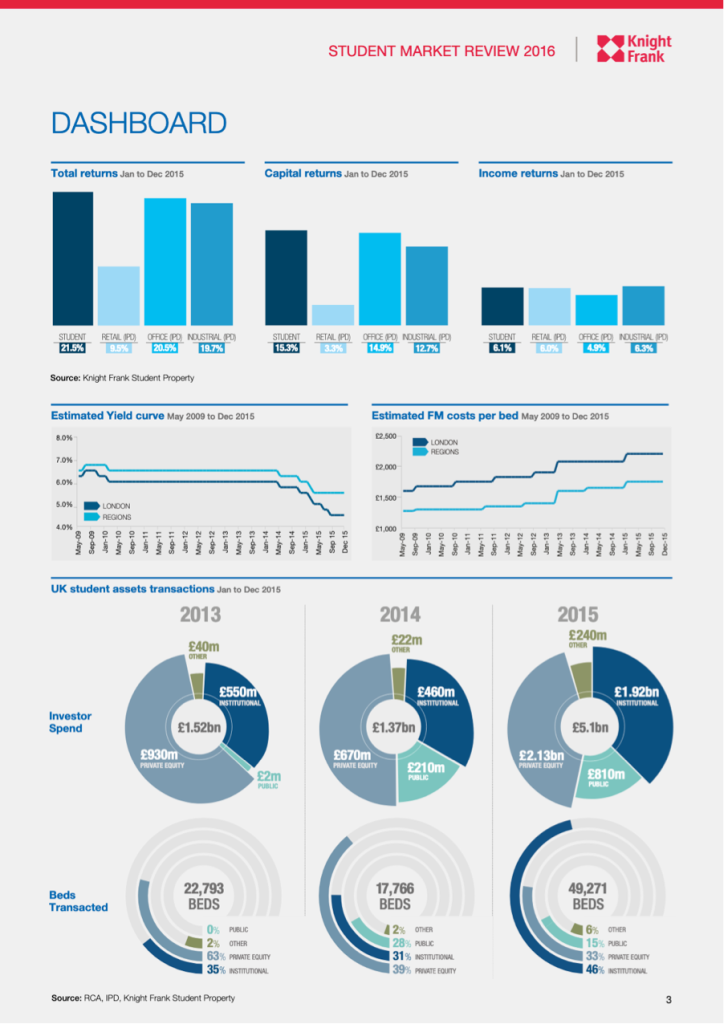
Such private-public partnerships are also the reason why the role of Residence Life Coordinator has taken on completely new dimensions when compared to any similar role in any of the previous models. The PBSA Residence Life Coordinator Role differs immensely even from the same role offered through the same Residential Life Model, when the model is being operated by the University alone. Compare, for example, the Residence Life Coordinator job description for UPP & University of Reading, with that for UPP & NTU (Nottingham Trent University), and then contrast those with the same job description when the Residence Life Model is run by a University alone.
These are just some novel features of the University &UPP Residence Life Coordinator job descriptions mentioned above:
– “Run Tell Us events gathering specific information from students to target/prevent any problems that might be mentioned in the Customer Satisfaction Survey and anecdotally”
– “Manage the h@h (Halls at Home) mobile app events and news article components.”
– “Manage all h@h student facing social media platforms.”
– “Write feedback reports and present findings to, NTU Student experience group, site management and the wider business.”
– “This role will include some evening and weekend working.”
– “The role is responsible for the implementation of the home at halls residence life programme, recruiting and managing student staff and volunteers and gathering student feedback to inform future planning.”
– “Review competitors’ facilities and services” (This criterion is only present in the UPP&University of Reading job description).
Overall, this new model, the Residential Life Services Model as it is called at Bristol University, or Residential Life/ResLife, as it is called at the University of Manchester, Newcastle University, University of Sheffield, University of Leeds, University of Exeter, is what has replaced the University Halls of Residence Model in quite a number of HE institutions. I have singled these institutions out because, at this point in time (the 16th of October), they constitute six of the top ten universities with the highest numbers of Covid-19 cases in UK higher education, judging by the UCU Covid-19 dashboard.
We can see now why universities that had replaced the model of the University Halls of Residence after 2010 (which, in truth, represented only a shadow of the collegiate system at Durham University that itself constituted only a weakened copy of the Oxbridge model) with the Residential Life Services Model would have been much less prepared to face a pandemic.
Considering that many thousands of students live in student accommodation, to leave day-to-day monitoring and disciplinary matters effectively in the hands of undergraduate students is a shameful dereliction of the duty of care and a psychological burden that no second or third-year undergraduate student should have to carry. One should really wonder how such young students[1] would have been pushed onto the frontlines of the Covid-19 outbreak in this way, in addition to being made responsible for dealing with the serious problems that generally affect student halls (alcohol, robberies, drugs, fighting, sexual violence, mental health, suicide). It is almost as if we were purposefully aiming to damage them. What authority would one or even several second-year students have over tens or even hundreds of rowdy freshers on a big night? Similarly, no matter how conscientious, lower administrative staff with an undergraduate degree could never have the same experience in offering pastoral support, in making themselves heard and understood by students, or the same say in alerting, informing or even challenging the different bodies of the university, when compared to academics with many years of previous experience in teaching/research/administration and in the role of Wardens. There is also a huge issue of numbers. Previously, each Hall had been managed by a Warden with a Deputy-Warden and their entire Hall team, with each Senior Resident directly responsible for a section of a block or for a block. In the ResLife model, the numbers of staff have generally been considerably reduced, with both the Residence Life Coordinator and the Residence Assistants/Advisors sometimes responsible for many times more the number of Halls (called ‘villages’ or ‘clusters’ etc) and students than in the past. Or, if their numbers have not been reduced, then, their hours have been. Similarly, these roles have now been tasked with an increased responsibility and active duty to gather information, predict, report and prevent any sensitive information about the failures of the university, or of their PBSA partners, from reaching other university channels or communities, social media platforms or the general public.
[1] This job description (within catered Halls, the duties of the Senior Resident would be the same with those of the Residential Adviser) provides a good insight into what the duties of such undergraduate students in this system are:
- “The Residential Adviser will help promote and maintain a peaceful environment that the students can enjoy.
- The Residential Adviser provides pastoral care and basic welfare advice and sign posting to relevant support services (both internal and external) to their students.
- The Residential Adviser assists in a wide range of tasks that ensure the smooth operation of the Halls and the Hall community.
- The Residential Adviser will be the first responder on hand to deal with emergencies and serious incidents arising during their on-call duty nights – as such they will be the first point of contact for Students, Emergency Services, Campus Support and members of the local community.
- The Residential Adviser will often need to make on-the-spot decisions to take definitive action, to contact the Warden, to call emergency services or other appropriate authority.”
Such a system was never meant to adequately deal with even the general pastoral issues of the day, not to mention having to deal with a pandemic. What is even more shocking is that this system was not reformed and reinforced in the first six months of the pandemic so that it would stand a better chance against the pandemic at the start of the new academic year.
At this point, one could remark that some of the universities that do not rely on the Residential Life Services Model are also showing a high or a considerable number of Covid-19 cases. Amongst them, Durham University – an exemplar of the Collegiate system. There are four things I would say here. The first is that even the Collegiate system could be rendered ineffective through cuts and restructuring. The second is that there still are other ways in which a University could have gotten their response to Coronavirus seriously wrong (to be discussed next). Third, most other universities that follow the Collegiate model are still doing relatively well in the UCU Covid-19 case dashboard.
Last but not least, some of the universities that have held onto the pre-2010 University Halls of Residence model have seriously altered and weakened this system, in ways that resemble, at least partially, the Residential Life Services model. This reorganization constitutes the second modality through which the organizational model of the University Halls of Residence has come under attack since 2010.
Model B.
In this version, the University Halls of Residence model was restructured in two ways:
1. Firstly, for catered Halls, cuts were made so that the same Hall team (Warden, Duty-Warden, Senior Residents or Resident Tutors, Hall Manager and/or Hall Assistant-Manager, Hall Secretary, Hall Porter, Hall Catering Team, Hall Cleaning Team, Hall Bar team etc.) previously responsible for a single Hall, was now left in charge of 3 or 4 such Halls, grouped together into ‘villages’ or ‘clusters.’ Next, as with the Residential Life Services model, the number of Senior Residents was cut, and their role geared towards second and third year undergraduate students. While this system did not take pastoral care out of the Halls, it nevertheless weakened it by rendering it so thin as to become largely inefficient. The reliance of such models on second year undergraduate students (deployed to the frontlines even in times of crisis) has already been critiqued before. The same critique stands here.
While in this system these undergraduate students could theoretically benefit from adequate mentorship and support, the issue, however, is that at every level, be it that of Warden or Senior Resident, the system is overburdened, overstretched and, thus, easily overwhelmed.
2. Secondly, the private-public Unite Students/UPP/IQ etc. & Universities model (or the PBSA model), which as discussed previously, is the more streamlined and radical version of the Residential Life Services Model, relying only on Residential Life Coordinators (Bachelor’s required) and Resident Assistants (usually second or third year undergraduate students), became the mode of organization for self-catered Halls, thus challenging the existent University Halls of Residence model from within. Some universities, like Oxford Brookes, for example, seem to be running entirely on this type of PBSA system, having entered partnerships with “third party residence providers” such as “Unite Students Ltd, CRM Students Ltd, A2Dominion and Host.”
This dual-model, with the first half, a cheap version of the pre-2010 University Halls of Residence Model, and the second half, the radical version of the Residential Life Services Model, in other words, the worst of both worlds from a pastoral care dimension, seems to characterize institutions such as the University of Nottingham and the University of Reading.
Less advanced in its transition towards such a model, the University of Liverpool seems to have retained a larger part of the pre-2010 University Halls of Residence Model, with one Warden (recruited from Faculty) per Hall (although Residential Advisers can now also be recruited from the ranks of undergraduate students). The same seems to apply to the University of Glasgow.
Model C.
Finally, some universities, such as UCL, the University of Warwick and Loughborough University seem to have been able to retain the pre-2010 University Halls of Residence Model, with Wardens recruited from Faculty and Student Residence Advisors recruited only from the postgraduate student community.
Assigning Responsibility:
In all these three cases (Models A, B, and C) the responsibility for decision-making regarding the running and administration of student accommodation rests with the same higher levels of the university. Let us take a quick look at the three universities with most Covid-19 cases in the UK since the start of term, as reported by the UCU Covid-19 dashboard. For the University of Manchester, it is the Registrar, from which responsibility flows downward to the Director for the Student Experience, and then to the Director of Residential Services. Obvious from the webpages shared here, the same centralized leadership now covers areas of student life and academic services that once had belonged to Schools/Departments or to more decentralized, semi-autonomous structures.
“The Directorate for the Student Experience (DSE),” we are thus told, “was established to facilitate a joined up approach to the delivery of services to students throughout the student lifecycle and to provide leadership to enhance the student experience. The DSE is made up of 5 divisions, and a central Directorate Office:”

For the University of Newcastle it is again the Registrar (both Risk Management and Emergency Response are also areas under this role) but also the Executive Board, while for the University of Nottingham it is again the Registrar, in a structure that seems to show a remarkable degree of centralization, and in which both Residence Life (Pastoral Care/Wardens and Tutors) and Campus Life fall explicitly under the Registrar’s responsibility:
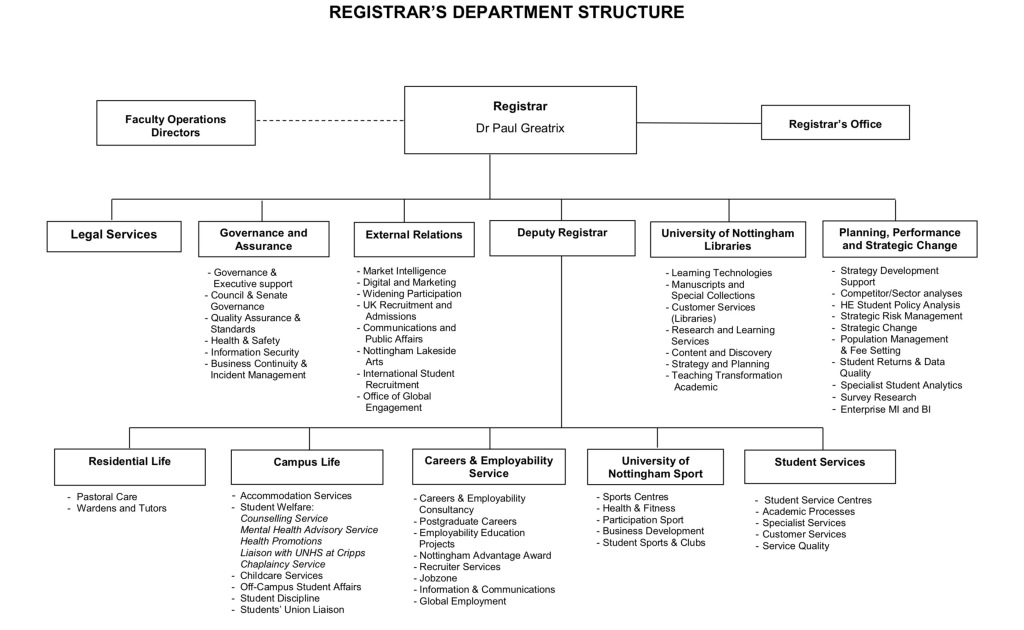
In contrast with the first three examples, the UCL governance structure is much more complex and possibly more decentralized, with the Registrar not nearly as significant a role as in the other cases (for example, if compared with the role of the Chief Operating Officer, of the Director of Estates, or with the roles of other Heads of Professional Services).
III.2. Not heeding the warnings that University Student Halls could be like Cruise Ships for Coronavirus
This point was extremely clearly explained in a Time article from 16 July 2020 by Katie Mack and Gavin Yamey:
<<Research has shown that air flow can transmit aerosolized SARS-Cov-2 much further than 6 feet. In the absence of constant and efficient ventilation, viral particles can remain airborne for at least 3 hours. In most universities, opening all the windows and doors would be impractical or impossible, and air conditioning systems can waft recycled air over occupants for hours. Masks help, but they’re not perfect protection.
Not surprisingly, many professors, particularly those who are older or have pre-existing medical conditions, say they will refuse to teach inside classrooms. But to be able to refuse, you need some degree of power. There’s a real risk that so-called contingent faculty, those in “insecure, unsupported positions with little job security and few protections for academic freedom” will have no choice—they will feel pressured to teach in person or be replaced.
Beyond the classroom, colleges and universities are ‘congregate settings’ that are known to create high risk for viral transmission, akin to nursing homes or cruise ships. The campus experience includes bringing students together in dormitories, dining halls, athletic training, parties, bars and clubs—gatherings that would risk becoming ‘superspreading events.’ …
For the city where a campus is based, reopening will be like dropping a cruise ship into the center of town—and giving passengers free rein. Campus outbreaks cannot be hermetically sealed—they will inevitably cause a spike in community spread, affecting the city, state, and beyond. Universities that fully re-open in the midst of an uncontrolled epidemic will bear responsibility for the damage they cause to their wider communities. [my emphasis]>>
However, it will be wrong to suggest that one would need to read some expert advice in order to foresee the real dangers that University Student Halls were likely to face in the case of a pandemic like Covid-19. Just the layout and location of the University Student Halls tells the whole story. With each major University having between 7 to 14 Student Halls (with most comprising 200 to 300 students but sometimes even going as high as having over 1000 students) on any one of their several campuses, all in very close location to each other and sharing the same urban and green spaces, and thus, giving the opportunity for thousands to socialize day and night (a unique and special opportunity after 6 months of lockdown), would it have been really hard to predict that student halls in October would very much operate just like cruise-ships in terms of spreading the virus?
After all, the BMJ had warned before the start of term: “Many outbreaks in US universities have been in congregate settings—such as dorms and off-campus housing—pointing to a third lesson. Viral transmission between asymptomatic students can occur at lightning speed in these settings.” Despite this, leading figures in UK HE still contend nowadays that the warnings about US universities and Covid-19 were never truly applicable to the UK, while simultaneously offering statements such as this: “However, I would honestly say I think the speed of transmission both within student halls and in off-campus settings took many, including me, by surprise and coping with that has been a huge challenge for universities.”
No surprise then that the Fallowfield Campus – “‘the epicentre of the epicentre’ as one student puts it,” a phrase that could be repeated of many a campus in other cities, has become associated with not so flattering a term as “covid soup”. We know that universities understood some of these issues from the very beginning, because many had initially reported plans to spatially distance inhabited flats in the halls. Which brings us to the next point.
III.3. Some of the most important universities in the UK did not reduce the capacity of their student halls despite the need for physical distancing
As reported by BBC Scotland’s Disclosure programme:
“The programme found some universities cut the number of students in halls of residence by as much as half but St Andrews University, the University of Edinburgh and the Royal Conservatoire of Scotland, in Glasgow, were at full capacity. … Eight other universities would not tell the BBC whether or not they cut numbers to allow physical distancing.”
The eight universities that did not answer are: Aberdeen, Glasgow, Dundee, Heriot-Watt, Strathclyde, Stirling, Edinburgh Napier and Glasgow School of Art.
Not surprisingly, the explanation has much to do with the profitable PBSA sector and with how universities have left themselves exposed in terms of what they have agreed to with private accommodation providers. The key issue: having signed up for a certain percentage of the rooms (presumably, a quite high number) being filled each year.
This has been wonderfully reported below:
“The Disclosure investigation also found that some universities are subject to ‘nomination agreements’ with private accommodation providers.
This is where universities enter deals with private developers to provide modern attractive accommodation. These deals may include guarantees from universities that a certain percentage of the rooms will be filled each year.
For instance, the University of Edinburgh has eight nomination agreements in place, with a fifth of its students living in accommodation rented from private providers.
Financial analyst Louise Cooper told the programme that there had been an explosion of student numbers in recent years and universities had turned over their property portfolios to private developers.
But she said the ‘risk’ of the properties being empty was generally being borne by the universities.
‘The underlying model requires high occupancy, students in there, paying their weekly, monthly rents,’ she said. ‘As ever, you need to follow the money.’
The University of Edinburgh said: ‘Throughout the pandemic our prime concern has been, and remains, the health, safety and general well-being of our students and staff. This will always come before any financial considerations.’”
The situation is even more complex in English Universities. According to the Guardian, experts reported concern that “although UK universities have drastically scaled back face-to-face teaching so that campuses can run at around a third of their usual occupancy, many student halls are full.” According to the same article, English universities “blame the A-level fiasco for pushing them to maximum occupancy.” As the reporting goes:
“Vice-chancellors reacted with fury this week to threats by the education secretary, Gavin Williamson, to dock their bonuses because of what he called the Covid ‘crisis’ in universities. One, who asked not to be named, said: ‘The government looked to universities to sort out the post A-level mess. They pleaded with us to take students who met offers. They were not interested in capacity, social distancing on campus, pressures in halls or private dwellings. Suddenly they have forgotten all of that and now universities are the problem.”
Is that the full and only explanation for high to maximum occupancy in student accommodation on campus and around the city? Most likely not, but possibly in part a convenient way to highlight the role of the government in a blame game that universities have been carefully weighing (and some suggest, playing) from before the start of term.
III.4. Testing, Self-Isolation and Basics
Questions about testing and tracing and self-isolation are questions about the pandemic, about society, about politics and economics. They are incredibly complex questions and the ground is shifting daily. Surely, all we can do at any given moment is judge ourselves against the best knowledge of the time, and against a basic standard of pragmatism and creativity.
A strong argument can be made from city to city and region to region that unless transmission in the general community and in the community of the university (both with a functional system of test, track and trace) was low, Universities should have never considered to open their campuses and should have instead moved everything online:
“What would it take to re-open safely? We can look to Taiwan as an example. Rather than leaving individual universities to piece together their own plans, Taiwan’s Ministry of Education produced a national strategy for college campuses. The strategy included an initial quarantine, frequent testing of all students, sanitation, masks, distancing, reduction of student density, cleaning of dorms twice daily with bleach, and allowing only one student per dining table. It also included mandatory quarantine for anyone exposed, and infection-number thresholds at which an entire university would shut down. With this huge array of protective measures on campus, Taiwanese universities were able to reopen successfully and see a total of just seven confirmed university-based cases by June 18, and only four new cases nationwide since then.
Aside from the safety protocols more rigorous than any we’ve seen proposed in the U.S., Taiwan’s universities had another advantage America’s don’t: a well-controlled epidemic with virtually no community transmission. To date, Taiwan has had only 451 cases and seven deaths. Not a single state in the U.S. has had anything like that level of success.
In that context, it’s hard to see how any U.S. university could have a safe on-campus reopening plan comprehensive enough to succeed.
We understand the financial pressures that colleges and universities are facing. Some could risk bankruptcy without the revenue that reopening will generate. We also recognize the enormous benefits of campus life and in-person teaching and the wishes of some students and parents to experience these. But at what price?”
At the same time, to those arguing that life must go on, that universities have done all that they could do to re-open safely, and that nothing more could have been done, reply must be given that controlling the virus is always a choice and a possible outcome, as long as community transmission is low to start with, test, track and trace is working, and as long as basic public health strategies are being acknowledged (as Taiwan’s example shows).
I would argue that, in terms of public health, several considerations would have been obvious to university leaders many months before the start of the academic term in September, but that managerial failure to act on them has led to the present crisis:
- That the £12bn test, track and trace highly-centralized scheme devised by the government (in a move that shifted existing resources from the public to the private sector, and responsibility and know-how from the local and regional bodies to the central government, thus causing a major delay and organizational havoc) would only be of marginal assistance to universities at the start of term. In other words, that universities would need their own testing and tracing schemes, until those of the government could replace them, if they wanted to prevent or, at least limit, any massive outbreaks. The chart below shows how the Test, Track and Trace scheme of the government was never really up to the task, namely, was unable to return test results fast enough for the relevant contacts to be traced and isolated in timely fashion. The same chart also shows that the test, track and trace system of the government was in no way at the capacity required for schools and universities to open; when these did indeed open, the system took a battering.
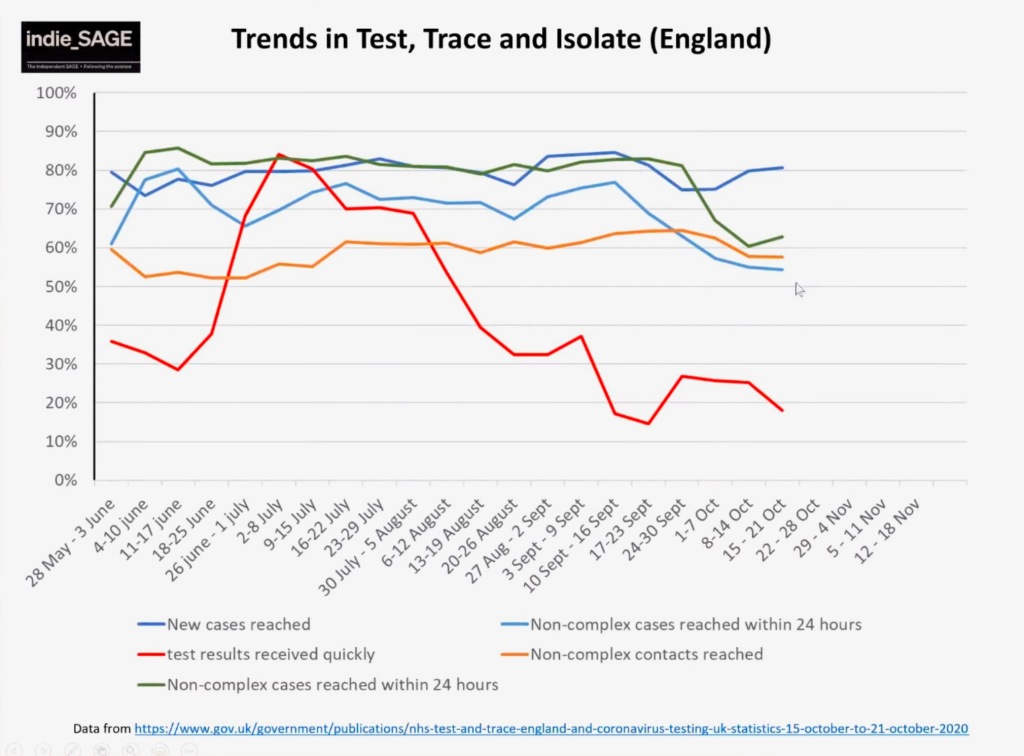
- That testing would have to be aimed at both symptomatic and asymptomatic individuals (youth are largely asymptomatic), be very wide and frequent, apply to both students and all types of staff, and occur particularly before the start of term:
“Model based evidence shows that preventing outbreaks requires high frequency screening of all students on campus. An epidemic modelling study found that, assuming typical behaviour of college students, universal screening using a rapid, cheap, high specificity test—even if low sensitivity—every two to three days is the optimal strategy.18
Frequent testing will not be feasible in all settings, but this strategy is in line with a recommendation from the UK’s Independent SAGE Behavioural Advisory Group, that if students in the UK have to physically attend campus, there should be ‘testing on or before arrival on campus followed up by further regular testing of students and staff.’19 Testing should also include lecturers and other campus staff (who may be older and at higher mortality risk from infection), and probably students living off-campus nearby.”
- That UK students should have also been asked “to restrict face to face activities and social interactions for the first two weeks of term” (according to the Independent SAGE).
- That without day to day careful monitoring of the social interactions on campus and in student halls, and an ability to intervene early and decisively, things could very quickly spiral into a situation that neither testing nor contact-tracing and isolation could any longer contain. That this was going to require an enhanced presence of very well-trained and experienced support staff in different roles on campus and in the halls, with very mobile campus-security teams also available as last resort.
- That face masks might constitute the only circuit breaker between students and between students and staff, if all other measures failed. Meaning, that masks would have to be considered as compulsory at all times not only indoors but also when more than two people are present together outdoors.
- That in the absence of adequate testing, contact-tracing and isolation would become key, resulting in a need to support students isolating in their rooms:
“Ensure full and generous support to students both to self-isolate and to access online learning resources, including practical needs (e.g., food, laundry), learning (e.g., IT, connectivity), and social and emotional needs (e.g., buddy systems, regular wellbeing checks, online events).” (see, advice from Independent SAGE)
- That “students may be reluctant to get tested if it means they and their friends must isolate for 14 days.” That “there may be further reluctance for contacts to isolate -especially if they are repeatedly contacted for different cases.” (advice from the Independent SAGE) This point deserves more attention because it might describe a reality currently underway:
“Some university students are struggling with weeks or potentially months of rolling self-isolation, because of the make-up of households in residential halls, NUS Scotland has warned. The head of the students’ union, Matt Crilly, has written to the Scottish government’s education secretary John Swinney, urging him to consider alternative, or additional, measures to self-isolation – including asymptomatic testing – to avoid long-term self-isolation among the student population. Large numbers of students are currently living in halls, in ‘households’ defined as sharing a bathroom or kitchen. When one student tests positive, all their household contacts must self-isolate for 14 days, but for asymptomatic students the clock resets every time a new member of the household develops symptoms.” (Source: Libby Brooks/The Guardian)
As any aspect related to the pandemic, this problem creates others:
“The government argues colleges and universities must continue in-person activities during lockdown so that learning isn’t disrupted. But learning is disrupted when the mode of delivery constantly changes due to staff and students yo-yoing in and out of self isolation.” (UCU)
Most recently, we have been told that in those universities that had the biggest outbreaks at the beginning of October numbers are now decreasing:
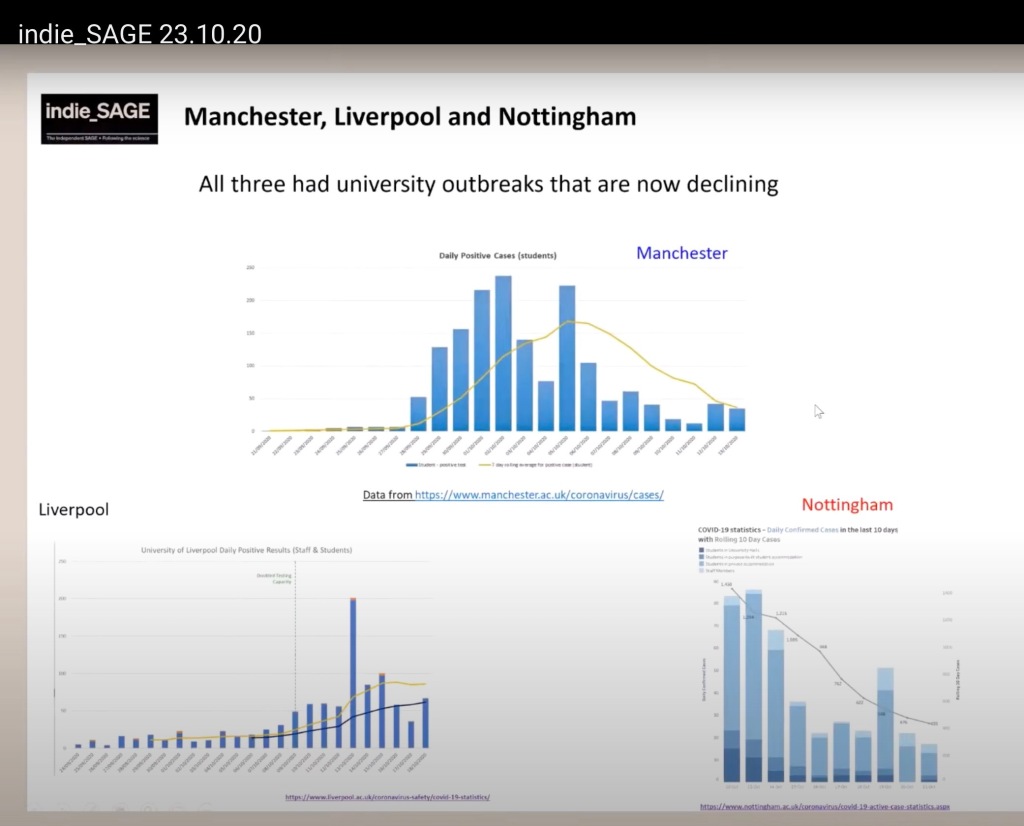
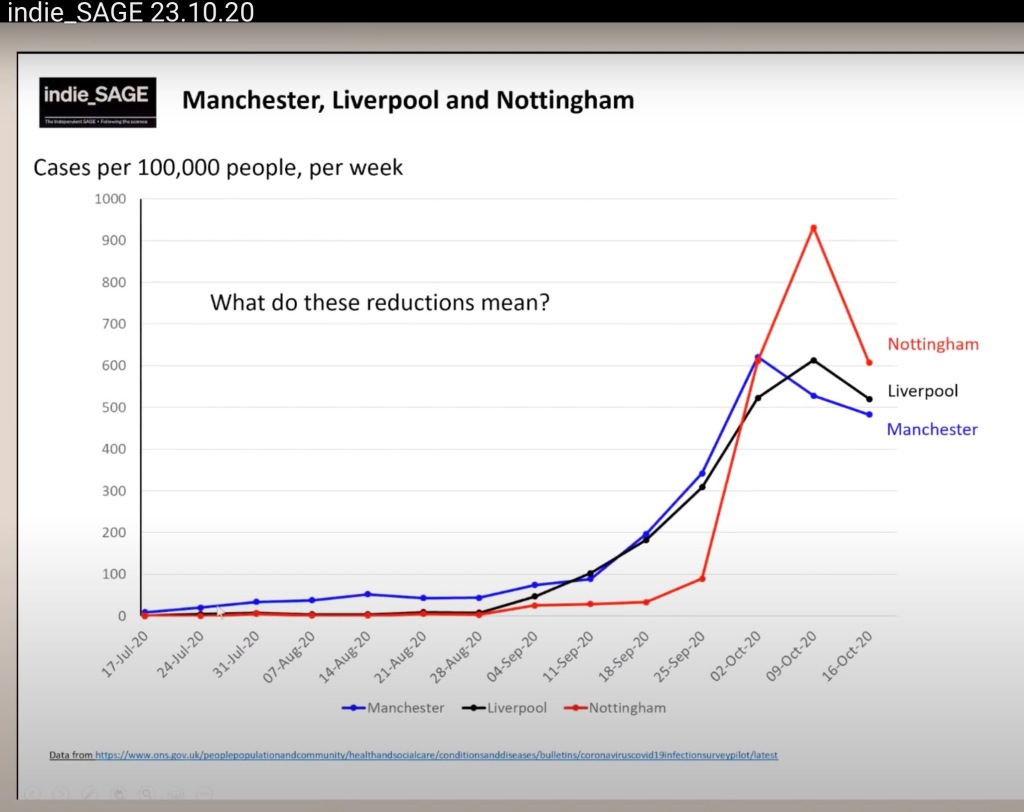
But what do these reductions mean exactly?
After all, both the university numbers of daily positive cases (students) and the number of cases the ONS would have gotten from the NHS test and trace are to some considerable degree self-reported.
In the university case, they are self-reported because they are either the positive cases the university has reported as having tested (with its in-house testing) or the numbers the students have reported to the university halls after testing positive via the NHS. Currently, universities do not even seem to offer a clear breakdown of these two sets of numbers. Universities also do not currently indicate how many in-house tests they are doing per day and what proportion of those are positive cases. Moreover, while some universities offer students and staff the opportunity to book in-house testing (usually asymptomatic testing), most others do not have enough capacity to do that. That means that in the latter case, in-house testing is only used in an exploratory manner at best.
On the other hand, in the NHS test and trace case, only those students that have symptoms and want to report them can book a test:
“You can only get a free NHS test if at least one of the following applies:
- you have a high temperature
- you have a new, continuous cough
- you’ve lost your sense of taste or smell or it’s changed”
To this, we also have to add the huge delay in the return of NHS tests (see third chart up), which most certainly skews the figures.
In other words, the picture is a lot more complex than the usual announcements on social media make it sound.
It might well be the case that the virus has already spread into those areas or contexts that were much more open and conducive to transmission, and that, from now on, transmission will continue at a slower pace. It might also be the case that having seen their friends experience the harsh reality of isolation, some of the students might have decided to delete the NHS app from their phone and to stop reporting symptoms to either the NHS or the university, while generally letting only their close circle of friends know of their situation. Take for example, a simple aspect of the reality of isolation in catered student halls, where the bathroom and kitchen might need to be shared with 4-16 other students:
“In her flat, Amanda’s daughter shares a bathroom and a kitchen with four others, which makes self-isolating difficult.
Amanda said: ‘She has to get into PPE to go for a pee. Then she has to disinfect everything – the flusher, the taps, the sink, the door handle before she can go back to her tiny room. It’s the last thing you want to do when you are feeling rubbish.’
‘She can’t access the kitchen at the same time as any of the others so she goes in there alone to cook in PPE and again has to disinfect everything – the taps, the surfaces, the cooker, knives if she has used them.’
‘She ran out of fresh fruit and veg early and is now on to the stock of dried food we sent her to Glasgow with.’” (Source: here)
While the scenario described above might sound speculative, that is exactly what would happen if students felt the university is failing in supporting them fully and generously with their period of isolation (or exploiting them as a captive market for financial gain). The fact that statements of this kind kept resurfacing in the press plus the rise in “student rent strikes” (Glasgow, Cambridge, Bristol) indicate that this scenario is not at all implausible (in fact, it would suggest that anthropological research into this area is greatly needed now if we are to understand the reality on the ground):
“Since the hall is normally catered, food during lockdown is delivered in bags to rooms.
She said: ‘But sometimes the meals are hours late or don’t arrive at all.’
‘Vegetarians have been delivered chicken meals – and when students call to complain, the numbers go straight to voicemail.’
‘Students in blocks which aren’t yet locked down have been passing food through windows to friends who have been told to isolate.’
She said communal areas are out of bounds even to groups of less than six and anyone stepping outside their room is ‘shouted at’ by security.
‘It’s like a prison or the end of the world. People can’t exercise, there is no-one around on campus, it’s really weird,’ the student continued.
‘We wouldn’t even mind the isolation if only we had an email explaining it.’
‘I’ve seen a good few people’s parents turning up to fetch them, telling them, We don’t care about the fine – get in the car.’” (Source: here)
“Despite registering as self-isolating on the first day it took just over a week for the food parcel from the university to arrive, and then, when it did, it was only suitable for two people and we were a flat of six,” he said.
Not only were the food packages insufficient, students said, but in many cases they did not contain essential items like cleaning products, tampons and sanitary towels.” (Source: here)
“At Lancaster University, an opt-in deal lets students get three prepared meals — including a cold breakfast, cold lunch and an evening meal which is to be heated — delivered for £17.95 per day. The deal is supposed to be a potential option for students who are self-isolating due to the coronavirus pandemic. However, a petition shared by students has accused the university of “profiting” off students in self-isolation, claiming the ingredients per portion cost less than £3.
‘These parcels … are the only practical way for many to get supplies, given a shortage of delivery slots,’ the petition, started by Kyle Westrip on Change.org, says.” (Source: here)
The problem with this scenario, of course, is that if students who have symptoms are not self-isolating, then university staff (cleaning staff, catering, porters, security) and teaching staff who engage face-to-face with students are placed, unbeknownst to them, at considerable risk. Some HEIs seem well aware of this, which is likely why Universities such as the University of Manchester are asking students “to report any staff or students who have had a positive Covid-19 test or are isolating/quarantining but have no positive test.”
- That the risk-areas in universities were “first-year halls of residence and face-to-face teaching.” This had been identified in SAGE modelling, which means, the government and PHE would have known this ahead of time:
“Prof Mark Woolhouse, who sits on the government’s pandemic modelling group SPI-M, said the situation was ‘entirely predictable’ and had been modelled. He said students were not to blame for the outbreaks and with students converging from around the country it was ‘inevitable there would be some spread’. Modelling showed the risk areas were first-year halls of residence and face-to-face teaching, he said. [my emphasis]”
While “face-to-face teaching” has been widely identified as high-risk much before the start of term (with no avail until huge outbreaks and subsequent industrial action), Professor’s Woolhouse’s statement from the 27th of September should also not have come as a surprise, considering the fact that catering halls (which, generally, are first-year halls of residence) are more like Covid-19 tinder-boxes than any other type of halls, both because of their internal layout (many students sharing a bathroom and kitchen) and because of how closely they are located to each other on any campus (meaning thousands of students can be in close interaction with each-other). Surely, those special committees tasked with assessing all university buildings for their level of risk in terms of Covid-19 would not have missed such a glaring fact.
- That without adequate induction so that the freshers/students are “meaningfully engaged in the reopening planning process,” understand the threat of the virus to themselves and the wider community, and are encouraged to study and monitor the disease as a public health crisis throughout their life on campus and in the city, these new arrivals would continue to dismiss warnings about the virus (as their age-peers and, sometimes, parents, have generally been doing in the months before, due to our divided politics and the highly politicized understanding of the virus in the US-UK media), and seek to live that student life that every generation of students starting university feels entitled to celebrate, and for which British universities are famous during Freshers’ Week. For those unfamiliar with the term, ‘Freshers’ Week’ has been aptly described by the New York Times as “Britain’s debaucherous baptism into university life, complete with trips to crowded pubs and dorm room parties” and the name does not do it justice because it can last even 2 or 3 weeks (like it did this start of term). I emphasize the importance of this term here because this social phenomenon, a very important part of the organizational and marketing side of the UK university, is absolutely key to understanding the huge Covid-19 university outbreaks at the start of term. We should not assume, however, that parties during Covid-19 tier lockdowns are only a student phenomenon.
- That “essential in-person teaching and learning (e.g., components of laboratory or practice-based courses)” should be made “contingent on the regular testing of students and staff, with a ‘dashboard’ approach as adopted by US Colleges.” I cannot emphasize it here how important this particular dashboard approach is, one that I do not believe any UK university has replicated yet: https://news.northeastern.edu/coronavirus/reopening/testing-dashboard/
It must be remembered here that universities were not generally the first to reveal the news about their positive cases of Covid-19. PHE directors, as has been discussed before, have also been reluctant. Universities and PHE directors generally started to report on the numbers to a limited extent, only after articles about the struggles of students with isolation in the halls appeared repeatedly in the press. The Covid-19 reporting of the Universities generally came in response to such articles and to the resultant stir in public opinion and also as a manner of tackling the huge number of parents desperately calling in for information. When the reporting did arrive, it generally failed to mention the numbers of students isolating. This could have been an important piece of information for members of the academic or administrative staff (including cleaners, catering etc.) universities were trying, quite forcefully in some cases, to invite back on campus. It is one thing to say you have 110 positive cases on campus. It is quite another to say 127 students tested positive for Covid-19 and “about 1,700 university students have been told to self-isolate” (Manchester Metropolitan University) or that 114 have tested positive and around 1,000 students are self-isolating. The Guardian states that “After examining all the published figures of Covid-19 cases at universities, UCU found Newcastle, Nottingham, Manchester and Northumbria universities have all reported having more than 1,500 cases of Covid on campus since the start of term.” Have any of these universities indicated how many students had been in self-isolation in the weeks where cases had been at peak level? Thousands most likely, but how many thousands? The standard response, has more often than not been to avoid the issue of the numbers of students in self-isolation through management speak:
“A spokesperson for the university said: ‘As of Friday October 2, we can confirm that we are aware of 770 Northumbria University students who have tested positive for Covid-19, of whom 78 are symptomatic.’
‘These students are all now self-isolating. Their flatmates and any close contacts are also self-isolating for 14 days in line with government guidance and have been advised to contact NHS119 to book a test as soon as possible should symptoms appear.’”
Inasmuch as universities have shown themselves scarce with the truth and seriously non-transparent at the time when the public good most demanded it, even going so far as to leave student residents uninformed about the Covid-19 outbreaks in nearby student halls in the early weeks, and inasmuch as both the university community and the general public deserve to know within 24 hours (and not after 3 or 4 weeks) about the Covid-19 contexts to which their lives are being daily exposed, this ‘dashboard approach’ is an absolute public requirement, for the good of the city, for the good of the region, and for the good of the nation. The added bonus is that with such a system (coupled with information about local levels of spread, hospitalizations, ICU occupation and deaths), the population will be able cut through the noise and propaganda in the media, and able to themselves make informed decisions about the amount of risk they want to take on. Citizens everywhere in the UK have generally shown that if given the right information at the right time, they will act unselfishly in the public interest. Rather than imposing from above different tiers of restrictions that reflect more political considerations than public health concerns and more the interests of big business and HEIs than those of the working and middle classes (and that sometimes contradict themselves in how or where they are applied), a more successful approach would be to have a similar type of decentralized monitoring and reporting at local level, namely, to be transparent at the level of the government, as also at the level of the university. To attempt to hide and contain information about an outbreak for three to four weeks (here I am referring to the information about social gatherings and parties first, second, to information about students with symptoms, third, to information about students who went into self-isolation, fourth, to information about students who have managed to order an NHS test, and only five, to students who have tested positive or are in self-isolation as a prevention measure) is to have condemned hundreds or thousands of people to hospitalization and Long covid and a number of those, and we will not know what this number will be until much later, to death.
This dashboard approach is also essential, however, because it helps us map and understand the phases of the disease in the University community. The general assumption is that there will be a big wave and then a low diminishing one. However, as the University of Michigan has shown (start of term was on 31st of August), “outbreaks don’t just happen at the beginning of term & then tail off for the remainder”; in fact, a second peak could be just a month away:
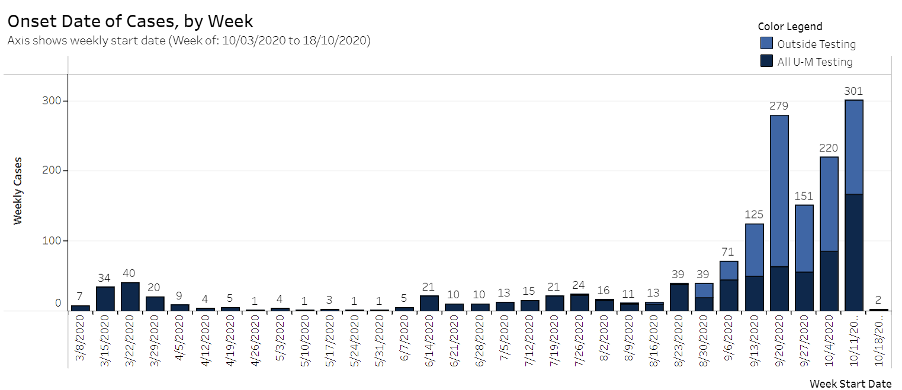
It is too early to say if UK universities could follow a similar pattern or not, but the University of Bristol has already shown us outbreaks might be occurring more often than expected:
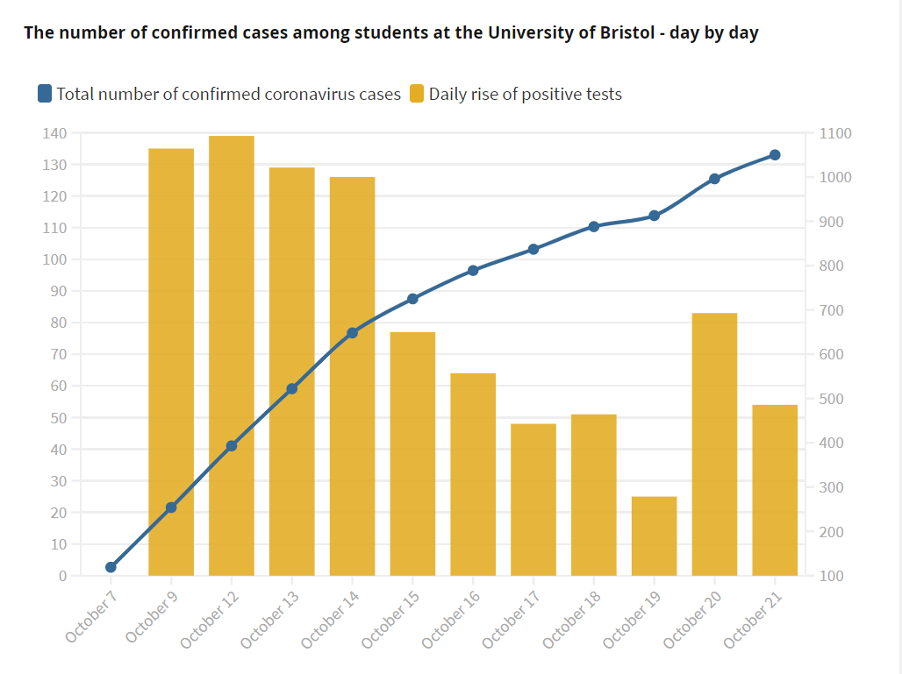
It is thus concerning to hear the Registrar of an important University which has seemingly started to invest heavily in in-house testing (which should be applauded) posing the issue of the Covid-19 dashboards in the following way: “But does just endless updating, sharing and compiling rankings of institutional case numbers help anyone? No. Rather it just feeds social and other media and the notion, quite wrong, that somehow this is all completely out of control and that students are.”
Covid-19 dashboards allow everyone to become informed about the reality of Covid-19 in their immediate surroundings (so they can take informed decisions about their lives) and nationally, and help us map and understand the phases of the disease in different University communities and, hence, the best way to contain it. They also shine a light on the effects of Covid-19 related policies in the HE sector and nationally. That such knowledge can be abused in some cases is a legitimate concern, but that does not invalidate such precious tools which exemplify the most basic and essential part of centuries-old public health responses to epidemics.
However, in order to develop a dashboard approach of this kind, Universities have to first significantly ramp-up their in-house testing (as far as I know, at the beginning of October only Cambridge, Imperial College London, Oxford, Liverpool, Cardiff, East Anglia and Exeter had announced having such systems in place), tracking and tracing capabilities and also the availability of NHS tests on campus. In an excellent article, the FT has highlighted the inequality of resources that exists between Universities when it comes to access to lab testing:
“While some institutions have struck deals with public labs, others have hired private companies or used testing facilities on site. What has resulted is an uneven playing field in higher education, with those universities that have money and resources able to test widely, while those without have had to make do with an often overwhelmed public system.”
The danger, of course, is that some universities will attempt to tick the box for having a Covid-19 dashboard but still do their utmost to reveal as little information as possible. An example of this kind is provided by Kingston University:
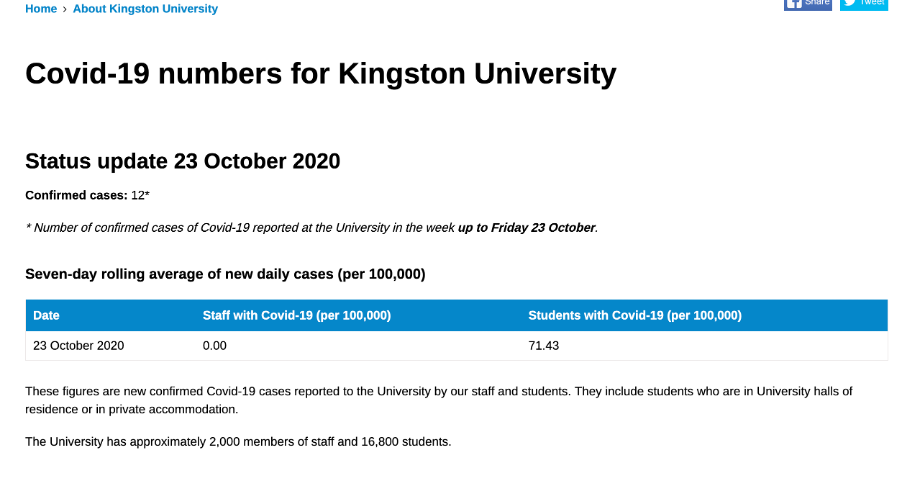
To conclude with, those universities that have not tackled the 4 operational failures highlighted above (see III.1 to III.4.) at the start of term might find themselves at a huge loss, not only financially and in terms of their global public image, but also, in terms of how their own internal communities and external local community would morally judge them if they thought themselves to have been treated as expendable.
IV. What happened at start of term? – A somewhat hypothetical retrospective
We now have enough elements to be able to put together an incipient and very basic retrospective account of what has happened at the start of term.
The return of students to English universities starts months before with the repeated insistence and assurances of English universities that students, be they home/EU students or international students, should attend university in person, unless international Coronavirus travel regulations prohibit them, or they have medical reasons or a disability:
“Do I need to be in Sheffield for my studies?
The campus will be open for the 2020/21 academic year and, where reasonably possible, you will be expected to attend. Our aim is to teach in small groups wherever possible. This will be supported by the best possible online alternative. This means that, in the Autumn term, large lectures will be delivered solely online.
We expect all programmes will include an element of face to face teaching, although the amount and frequency will vary depending on the discipline. Your department will provide further detail about what this will be like for you.
Despite these safety measures, we understand that some students may be temporarily unable to attend on campus, due to international travel restrictions, medical reasons or a disability. We are committed to ensuring that you are not excluded or disadvantaged for this reason. You will be able to access all our digital learning online, until you are able to join us later in Semester 1 or at the start of Semester 2.” (Source: here)
This application of these regulations, typical of almost any English university, will eventually become more flexible, but generally only after the return of students had ensured that most student accommodation places have been occupied. Students start returning from the 1st of September with first-year students starting to arrive in the second and third week of September for an official start on 21st of September. Most returners also begin to arrive at the university in the week prior to the 28th of September (some a week earlier, and some a week later).
At this point, geography also becomes important. Almost every older university accommodates their first-year students in catered Halls, grouped together close to each other directly in the heart of the campus, and administered directly by the University. We are talking here about several thousand first-year students grouped together in Halls of usually 200-300 students (with 4-16 students per bathroom and kitchen), but which can sometimes include a much higher number of students. Next, a layer of self-catered Halls, usually of the PBSA kind, circle such campuses from just outside of their borders. Recently constructed, these halls are oftentimes built like fortresses that could accommodate more than a thousand students (with usually 4-6 students per bathroom and kitchen), although they differ in size and variety, catering to the different needs of the most affluent layers of the student population. Furthermost removed from campus are those types of housing offered as student accommodation by the private sector. These are usually clustered in particular neighbourhoods of districts or boroughs, usually close to the city-centre, or close to the university but in a low-price residential zone. If catered Halls are dominated by first-year students, PBSA usually holds second and third-year undergraduate students and PGT students, while the private sector accommodation usually caters for all groups (UG, PGT, PGR) minus first-year students. This layout, however, would only be applicable to universities that have a sizeable campus which is removed, but not too far removed from the city centre. For other universities, like Lancaster and Warwick, the campuses are much further away from the city, so if transmission between students and staff is prevented, most of it should not reach the city. On the other hand, for universities in big cities, such as London and Manchester, the three distinct layers (University Student Halls on campus, PBSA and private accommodation) do not exist separately but are either superimposed on local city residential areas (taking over a vibrant suburb such as Fallowfield, for example) or interspersed amongst them. Obviously, the more concentrated the student residential areas are, the more likely and visible a potential outbreak is, with the reverse also being the case: in those areas where student and city residential areas are integrated, a possible outbreak would be harder to spot, as the spread would be slower but much wider in scope (which I suspect is the case for London).
As observed before, some of the most important universities in the UK ignored warnings that University Student Halls could be like cruise ships for Coronavirus and did not reduce the capacity of their student halls to allow for some measure of physical distancing. Moreover, many English universities reached maximum occupancy levels, a fact they have blamed on the A-level government fiasco, but which, as the example of the Scottish universities clearly shows, might be more directly related to loans conditions and debt thresholds Universities had signed up to as part of their deals with PBSA providers: ‘The underlying model requires high occupancy, students in there, paying their weekly, monthly rents.’
As we have also touched on before, very few universities (usually the ones hosting huge laboratories, such as Cambridge and Imperial College, or those being able to strike deals with nearby public labs) had developed in-house testing, or had hired private companies to supply them with tests and/or perform testing on campus, before the start of term (possibly Oxford, Liverpool, Cardiff, East Anglia and Exeter). Even for most of these, initial testing capacity would have been generally low at the beginning. It would seem that in the few weeks before and after the official start of term on the 21st of September, most universities were not even yet capable of making NHS tests available on campus or, in general, accessible to the student population (here, the government is clearly at fault, too). It is obvious then, that with the exception of maybe the University of Cambridge, Imperial College and few others, testing of students and staff did not occur on or before arrival on campus and was never wide and frequent, with some basic forms of testing only starting to be developed by the second week of October in Russell Group universities.
It is therefore surprising, that while being pretty much in the dark in relation to testing, and with the student halls at maximum occupancy levels, Universities did not choose to control things better through regulations and structures on campus, or through partnerships with the private and public sector in PBSA locations and in the suburbs.
As discussed at length in section III, students were not asked to “to restrict face to face activities and social interactions for the first two weeks of term,” were never offered an adequate induction into the threat of the virus to themselves and their surrounding communities that would allow them to be “meaningfully engaged in the reopening planning process,” and were generally left unattended on campus. It seems as if those in charge were trying to re-open universities to students in the era of Coronavirus, without impinging in any major way on the ‘student experience,’ or the liberties of students. This also explains why masks were not made compulsory at all times or when more than two people from different bubbles were gathered together outside. Although masks constituted the only remaining circuit breaker between students and between students and staff, if all other measures had failed, the university guidance only stipulated that “a face covering is mandatory within any indoor settings.” While an injunction to wear face masks outside on campus might seem to many an infringement of individual liberties, the choice not to issue the call is likely to have contributed decisively to some universities developing huge outbreaks at the start of term. The University of Liverpool showed that a different policy was always possible (Newcastle University had an intermediate position on the matter, but still a better one than most):
“It’s mandatory to wear a face covering on campus, including during teaching sessions and when you move from one location to another. We will provide you with two free, washable face coverings when you arrive on campus and you will find disposable face masks available within buildings if you need them.”
In addition to this, universities also ignored SAGE advice highlighting that the risk-areas in universities were “first-year halls of residence and face-to-face teaching.” First-year halls of residence were generally not reinforced, either in terms of direct staffing at different levels, or in terms of campus security support. This simple neglected fact is at the heart of entire story. On the other hand, universities pushed very hard for administrative and teaching staff to return to campus in face-to-face roles, tendency that did not lessen even at the height of the outbreak for many universities (exceptions here are the University of Manchester, Northumbria University, Manchester Metropolitan University, Sheffield University, several of the universities in Liverpool and, for this entire term, Newcastle University; however, Manchester Metropolitian University is already seeking to return to face-to-face and some of the others might be doing the same before too long).
Earlier we have discussed how University student accommodation had gone from a pre-2010 University Student Halls model derived out of Durham’s Collegiate model, towards models that intensely emphasized the reduction of costs. We have noted how the Residential Life Services Model, a model that effectively took pastoral care out of the student halls, and which is most extreme in the PBSA sector, characterizes many of the top ten universities with the highest numbers of Covid-19 cases in UK higher education, judging by the UCU Covid-19 dashboard.
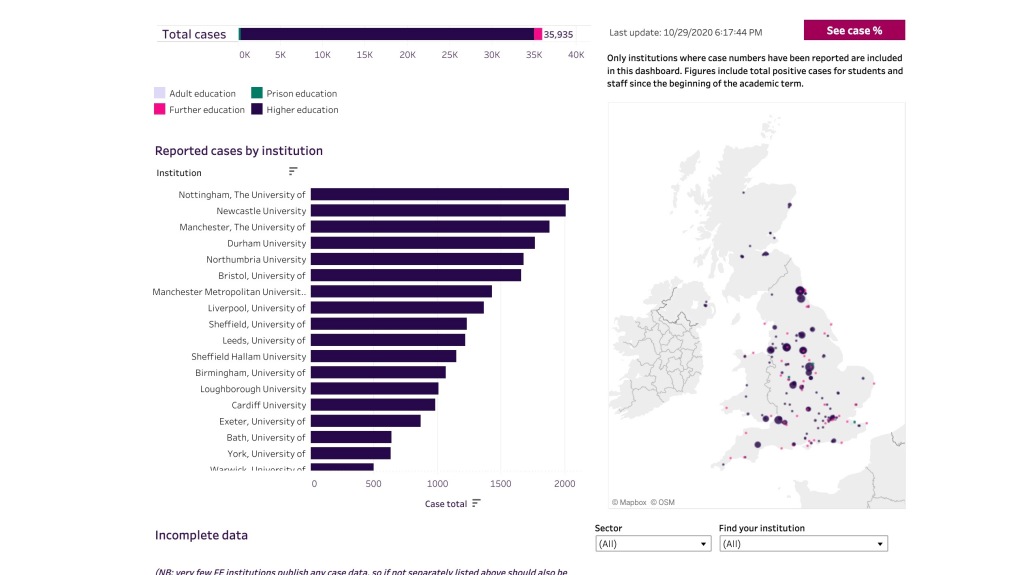
We have also seen how some universities have reorganized the pre-2010 University Student Halls model still functional in their self-catered Halls through such massive cuts that the remaining Hall teams (Warden, Duty-Warden, Senior Residents or Resident Tutors, Hall Manager and/or Hall Assistant-Manager, Hall Secretary, Hall Porter, Hall Catering Team, Hall Cleaning Team, Bar team etc.) were assigned 3 to 4 times more Halls and students than in the past. While this system did not take pastoral care out of the Halls, it nevertheless weakened it by rendering it so thin as to become largely inefficient. We have also shown that the same universities chose to adopt the more radical PBSA model for their catered Halls, thus relying effectively on a dual model. In a complete break with the past, these two new models left day-to-day monitoring and disciplinary matters in the hands of second and third-year undergraduate students, managed either by lower administration staff with Bachelor degrees, or by Wardens and Tutors with such an increased portfolio of responsibilities that they could hardly find the time to mentor and administer their resident tutors. The constant reduction in numbers of porters, cleaners and catering staff in the Halls is, in many cases, the reason why so many universities failed so spectacularly to adequately support students through their self-isolation period this year (with some deciding to offer food vouchers as compensation). Although not part of the Halls, similar cuts at the level of campus security staff exacerbated the distinct lack of preparedness in the Halls, to the point of incapacitating them in times of crisis.
We now have enough of the ingredients to be able to picture what might have happened at the start of term. Numbering in the hundreds, first-year students arrive on campus, together with their parents, in the week/s before the 21st of September. Hundreds or maybe thousands of students and parents gather outside, in different areas of campus, without wearing any masks except inside buildings, thus starting a trend of large groups socializing outside, without any masks, that would continue for weeks to come. University rules do not prevent this, and either way, even if they wanted to, hall-staff and campus security do not have the numbers to intervene (setting rules is one thing, enforcing them is another). An aside word is required here. Although the ones to be blamed least, after the central government, universities and PHE/local government, ordinary students and in particularly parents, bear a certain responsibility for the university Covid-19 outbreaks. This is so because both parents and students wanted life to be normal, “they wanted campuses to return to normal” and in doing so, they neglected basic public health measures that they might not have neglected in other environments. Parents and students wanted ‘the student experience’ and universities generally made sure this was on offer:
“Parents and students are miffed because they don’t really buy teaching when they pay tuition. Instead, they get something more abstract: the college experience. Some of that experience involves education—the seminar discussion in a facsimile of a medieval monastery, the cram session under the vaulted ceiling of a library, the brisk, after-class chat with a professor across a grassy quad. But most of it doesn’t, especially the stuff that can’t be done from a distance, such as moving away from home for the first time, swilling booze at a house party, touring houses during sorority rush, applying face paint for a football game, decorating the cold, cinder-block walls of a new dorm room.” (Source: here)
“She argues that vice-chancellors have ‘sidelined the scientifically informed, serious concerns of unions’, in favour of ‘peddling the fiction of a Covid-secure campus where an only slightly modified experience was waiting for students’”. (Vicky Blake, the new president of the University and College Union, as interviewed by the Guardian)
It is only normal to presume that when faced with large groups of students that have been socializing very closely and without masks for hours, if not days, and knowing that neither the rules nor the numbers are in their favour, the few staff on campus prefer to keep away and not put themselves at risk unless their job requires it. As such, the students are left largely unattended on campus. As the night closes in, large groups of students go (via public transport) into pubs, bars and clubs in town starting the Freshers’ Week parties a week ahead of its official start on the 21st of September. Going out is usually preceded by a pre-lash (pre-drinks as a cost-saving technique) in the halls. Some of the freshers go out too and return back to their catered Halls on campus in sizeable groups and in a state of post-euphoria that vaporizes any Covid-19 concerns many of them might have once held. But not all go into town, which is expensive. We know that large parties are launched inside the halls:
“I’ve heard horror stories of massive parties in some of the halls around here… it is just frustrating that no one else could have foreseen that.”
The following article from the Bristol Post is noteworthy in that it provides a really interesting summary of the first few weeks in first-year student halls (PBSA), while also touching on the fact that the university initially refused to disclose the amount of cases of Covid-19:
“‘We have been isolating since Monday,’ she added. ‘I am surprised we didn’t go into lockdown earlier.
‘I know people in five flats in our floor that have tested positive for covid and I would say every floor has, at least, a couple of flats with people who have tested positive.’
‘Cases have been going up for quite a while because of all the parties.’
The student said that the first couple of weeks after people moved into the halls there were a lot of parties, but she claimed security only shut down a small amount of them.
Those parties could have well over 40 people, she continued, as they would be announced in a Whatsapp group for the halls which has more than 300 people on it.
‘During the first week, there were multiple parties every night,’ she continued. ‘By the second week, they started closing them down and issuing warnings.’
‘I think the university should have done more to stop the parties – I don’t think we would have needed to go into lockdown if they had.’
‘I think the university could have done better.’
‘They refused to disclose the amount of cases of covid so no one knew how bad the situation was in Courtrooms.’
‘This meant people continued to go on about their lives as if we had a small amount of cases.’
She said that some students did take coronavirus seriously, but that there were a lot of students that didn’t. Some are starting to worry now, she continued, especially as some people had gone back home and then their family members had tested positive for coronavirus.”
As another article documents, student parties continue even after an outbreak has been declared and are being attended by students “who have either tested positive or should be isolating:”
“Students living at a Leeds halls have spoken out about what it’s like to live with people who flout coronavirus rules and restrictions – even after they’ve tested positive.
The residents of Marsden House, on Burley Road, have reported a large number of parties attended by people who have either tested positive or should be self-isolating.
One resident, who has already had the virus warned fellow residents, but now feels it’s pointless doing so. She said: ‘I think until people get it, and they become unwell, they’re taking it for granted. I mean I get it, you’re at university, you want to socialise and all that, but people need to be careful. I spoke to a few people living in the area when they said they wanted to have a party and tried to talk them out of it, but that wasn’t happening.’
Inspector Andy Loftus, who heads the Leeds North West Neighbourhood Policing Team, said: “We are aware of a number of recent incidents within the student community and have responded accordingly to ensure any offences are appropriately investigated. … Some of the recent issues we have seen relate to large gatherings or parties which are in breach of the current Coronavirus regulations.” [my emphasis] (Source: here)
The story of the halls at University of Leeds is really the story of student halls all over the country. Students start parties in the halls, then either ignore the repeated warnings of staff or proceed to have large gatherings outside the halls instead:
“Meanwhile students at the University of Manchester were filmed throwing an illegal party outside their student halls. …
Meanwhile footage recorded at 1am this morning showed a large gathering outside of Owens Park halls in Fallowfield, south Manchester, with one clip captioned: ‘Covid wah?’. Another clip shows a sea of people dancing to music which appears to be coming from a sound system.” (Source: here)
As we can see in the footage here, a scene repeated in other campuses across the country, the outside party seems to have at least around 100 students or more attending it, all very close to each other, like at a music festival. The staff in the halls at this time of night, oftentimes one second year undergraduate being the tutor on night-duty per several Halls, has probably called all night for assistance from the campus security staff, who are supposed to assist. However, the campus security team also does not have the numbers to cope with hundreds of students partying, especially not at night. Because of this, such superspreader events take place several days in a row until either private security or the police, or both, are brought to campus to police the halls at night:
“And at Birley Halls, accommodation for Manchester Metropolitan University students, residents claim around 100 people were partying till the early hours of the morning last Monday and Tuesday night.” (Source: here)
It is these events in first-year halls that are the ground zero of the largest outbreaks in English universities. Sure, there are parties everywhere, but there are thousands of freshers on campus, the superspreader events last for days, and students do normally migrate between parties several times per night. That is normally no comparison for a house party with 20-30 people, unless, of course, one suburb has very many such parties every night also. More likely to compete with such events are PBSA student parties that can hold around 40 students in halls of usually 300 but which, exceptionally, can also have about 1000 students. Several such PBSA buildings, and usually they are not that far from each other, would probably be likely to develop more cases faster than private sector houses in a suburb. Of course, there are always exceptions.
By this point in the story it becomes clear that a dominant view amongst the students is that the virus can in no way affect them and, that, therefore, there is no harm in further spreading it between themselves, a perspective universities have not done enough to challenge:
“Another student living at Marsden House said: “One of my housemates tested positive and he’s literally always in the kitchen and going into other people’s rooms. For whatever reason, a lot of people living here have an attitude of not caring if they get the virus.” (Source: here)
Some have suggested that this particular view about Coronavirus, as well as the disdain for masks, both observed on many other campuses, might have something to do with social class. (However, it is too early to draw any conclusions about how class might be playing into this.) At least one account highlights this, while also indicating that even this early on, meaning, before isolation periods were imposed inside the halls, students were concerned with escaping track and trace (and, also not bothered about security on campus):
“One unhappy student said there have been huge nightly gatherings outside her room as she tried to study. She said many students living at the £250 a week catered Streatham Halls had come from boarding schools and were from wealthy families. She said nobody was wearing a mask or respecting coronavirus warnings.
She described how the Exeter students stubbornly refused to go back into their rooms for 20 minutes after security staff arrived. She shared a WhatsApp group chat that says tonight will be ‘bigger and better’ with a DJ bringing loud music.
She said for two nights ‘None of them are wearing masks and social distancing isn’t happening. They were being quite stubborn and refused to go back into their rooms for quite a long time.’
‘I have parents with underlying health problems and family in Devon and know that the RD&E is overstretched enough.’
‘None of them seem to care about giving the virus to each other or to local people in the community.’
‘They are also sharing on the group chat about how to sneak in to Wetherspoons and avoid the Track and Trace.’
‘These are the most expensive halls on campus. They are catered halls and they cost £250 a week. Most of the students have come from boarding schools.’” (Source: here)
At this point, it is probably worth reminding the readers Gavin Yamey’s words of wisdom about students and parties:
“Any prevention strategy that is based on personal responsibility and the expectation that students will never go to parties or have sex is bound to fail. It has been disheartening to watch university leaders blaming students for outbreaks instead of admitting that the university’s reopening plans were dangerous.”
By the 21st of September a lot of universities have some positive cases of Covid-19 and some students isolating, but the information is not generally shared with the other students on campus, or the wider university community, and also not shared publicly. Since students have been partying in the hundreds since at least the 14th of September, with visible superspreader events and countless parties at which security or the police had to intervene, this cannot come as a surprise to universities. Despite such internal news (including the superspreader events), universities start calling on administrative and teaching staff to return to campus and work face-to-face. These staff have been off campus for months, they generally have no way of knowing the current reality on campus.
Such is not the case, however, with the catering and cleaning staff, which, almost from the first arrival of students, end up as that segment of the university workforce having to expose itself most to the virus on campus:
“The Pollock Halls worker, who did not want to be named, is also concerned about students still arriving at the halls while coronavirus is rife.
And they said catering staff working there have, as of Monday, been redeployed to help distribute parcels – including food and external deliveries – as most of the wardens and security staff refuse to go inside the buildings because they ‘don’t feel safe.’
They said: ‘Catering staff are doing it because they have not got any work to do and they are taking the parcels in but I am not sure they realise all the buildings have positive cases. They are delivering parcels to doors.’
‘Security had to disperse a group of seven just the other night but they (students) just found it funny as they were saying, <we have all tested positive anyway so what can you do?.> They were taunting them.’” (Source: here)
As Katie Mack and Gavin Yamey have observed in Time magazine:
“Infections among students will also put the lives of others around them at risk. The highest risk of death will be among service and maintenance staff on campus—cleaners, bus drivers, food service employees, janitors, facilities managers and support staff—who wield little institutional power.”
This is just another way in which UK universities mirror very closely the response of US universities to Coronavirus. But let us continue with the story.
Obviously kept in the loop, SAGE notices the rise in cases at universities and on the 21st of September (the official start of Freshers’ Week) Boris Johnson announces that from Thursday the 24th of September restaurants, pubs and bars will close at 10pm (instead of announcing the circuit breaker recommended by SAGE). The thinking is to limit the extent to which the transmission from within universities is spreading into the city. However, no measures are announced for universities and universities also do not take any measures except to significantly beef up security and try to increase (sometimes aggressively) numbers of face-to-face staff on campus. As it turns out, the PM’s decision further complicates the picture. Forced to return early from partying into town, students start hundreds of parties in their own student accommodation, particularly in suburbs, where they live in private accommodation. This is not new this September, but the trend is accelerating. Later, local police forces in different university cities will report having had to stop hundreds of parties in the suburbs in those weeks. (One might think that this is now in the past, but policing parties is still very much an issue even in tier 3 regions at the moment.)
Between the 21st and the 28th of September it becomes clear to university leaders that major outbreaks are underway in a number of large English universities: a considerable number of students are positive and many more are asked to self-isolate. This could not have come as a surprise considering the reports likely to have been sent in by tutors, security, police and concerned citizens during the week of 14th to 21st of September (or even before). The effects of 7-14 days of partying, large gatherings, and socializing with no masks in the thousands start to show from the 25th of September as outbreaks in student halls (especially in catered halls – the halls of freshers) start to grow exponentially (or testing capacity starts to catch up with the number of cases). In general, neither Universities, nor PHE or the government make this information immediately public. Local press might report a concerning rise in cases in the city but not much more. The wider university communities, most of the parents, and the surrounding local communities will only begin to find out what has been happening from around the 29th of September onward, when the first data about Covid-19 student cases at several English universities makes it on TV and in the news (Sky news, for example). The week after, the issue gets highlighted in local newspaper articles portraying the plight of students in self-isolation. General data regarding the spectacular rise in numbers of cases in particular cities also makes it into the media, and different press outlets start speculating about a connection with universities. Midway through the same week (i.e., second week of October), high numbers of positive student cases start being reported in the press for different universities. Generally, only after the outbreaks have approached or even reached their peak (between the 9th and the 23rd of October), four-five weeks later from the arrival of students on campus, do university and PHE authorities generally start to report on the numbers of positive cases at universities. Later, UCU branches like UCU’s Newcastle University branch would claim that the university had “refused to provide necessary information about the extent of the outbreak.”
Nevertheless, universities starting to report Covid-19 data is good news as it means these universities have finally developed some in-house testing or have made some NHS testing available on campus. Still, most universities do not mention the numbers of students without a test result that are currently in self-isolation. Under pressure from students, student unions, parents and the press about their failure to support students in the Halls during their period of self-isolation, some universities allow self-isolating groups of students to go outside into outdoor areas of the halls specifically designated for them or to get some exercise on specific locations on campus, all between certain times:
“They say food parcels have been insufficient and welfare checks sporadic or nonexistent, while young students have been confined to their flats for 24 hours a day, with no opportunity to exercise or, in some cases, even see natural light.” (Source: here)
“All students to have access to outdoor space in the event of a lockdown where they can exercise and get fresh air” (from the list of demands presented by Bristol SU to Bristol University)
That is the plan, but at least for some universities, without proper enforcement, this leads to a blurring of lines between students and self-isolating students on campus. Other universities advocate a much tougher isolation system, where such exceptions are not allowed. However, in terms of how processes have been set up, all aspects of self-isolation are largely self-enforced. Student halls, we need to remember, lacked in pastoral care capacity or in capacity to enforce rules from the very beginning. Even with hiring 24 hours security or more temporary porters, student halls cannot be policed. Universities can bring the actual police force in, as they have done in Manchester or in Scotland, but this can only be very temporary and the damage to relations with students can prove extremely costly. On the other hand, considering that this period in the UK has seen only 10 percent of people complete their self-isolation period (it was 20 % before the start of term), can we realistically expect students to fare five or ten times better than the rest of the population without any essential changes to the existent model of student accommodation, to the university’s response to Covid-19, or to the government’s Coronavirus strategy? Are not freshers the victims in all this, also?
The numbers of student cases are now dropping fast in the universities that had the biggest outbreaks to start with. However, the picture is not entirely clear when it comes to testing. As such, it is difficult to ascertain if this means that universities are now in control of the outbreaks, or that the outbreaks have run their course in those areas that were most exposed and are now spreading at lower speeds in more insulated environments. As observed before, it might also be the case that having seen their friends experience the harsh reality of isolation, some of the students have decided to delete the NHS app from their phone and to stop reporting symptoms to either the NHS or the university, while generally letting only their close circle of friends know of their situation. While this scenario might sound speculative (although such warnings were given by the Independent SAGE), that is exactly what would happen if students felt the university was failing in supporting them fully and generously with their period of isolation (or exploiting them as a captive market for financial gain). That is also what would likely happen if students were ideologically opposed to the idea that Coronavirus is enough of a health concern to require social restrictions or lockdowns. Clearly, anthropological research would be most welcome here.
Faced with difficulties such as these, by the fourth week of October, the universities that have enough resources decide to really ramp-up their in-house testing. It is a very late admission that testing and tracing are, after all, essential, as the expert advice had been suggesting all along. We have now moved to a new stage in the Covid-19 game. The start of term period has ended, and huge outbreaks have occurred that are now either slowing down or beginning to decline for many universities. For universities that have done better, the outbreaks are there, but the numbers are rising much more slowly. Others are just now seeing numbers rise fast (Bristol, Leeds, Birmingham and Cardiff), although not as dangerously quick as other universities at the start of term. In this new phase, the big issue for the universities is containment and control of the virus in the student population and staff population, while teaching and student administrative support goes face-to-face. That is not quite the same priority the city and the region have, which is to stop transmission from the university, although in many cases, we are probably passed that point. Meanwhile, several large universities have stopped face to face teaching after having seen large outbreaks (the University of Manchester, Northumbria, Manchester Metropolitan University, Sheffield University, Northumbria University and several of the universities in Liverpool, but Manchester Metropolitian University is already seeking to return to face-to-face and some of the others might be doing the same come November). However, most other universities still want to continue with some measure of face-to-face support, even as considerable opposition rises from their respective UCU branches. In the looming battles to come, widespread and frequent testing seems to have been embraced by the leadership of universities as the solution to all Covid-19 related problems. After so much resistance, and so much pain for some of these universities, the realization that structural changes must be made to the status quo in order to deal with the pandemic (and its financial costs) has finally arrived. For the moment, this realization only concerns itself with the ramping-up of testing. However, if a similar outbreak were to occur again, calls for a review of the entire system of university student accommodation, of pastoral care and of student support services, might also become louder.
V. Underpinning Rationales
V.1. General Logics at Play. Questions to Ask
Simon Marginson was one of the first experts in higher education to ring the alarm (on the 17th of July 2020) about how the logics of government and of universities had been combining to emphasize financial income, the bottom line, and a culture of marketization and excessive individualism over student welfare and the public health of cities, communities and the nation.
In a phrase that deserved a lot more attention at the time, Marginson remarked how both the government and universities were systematically providing students with “misleading” and “over optimistic claims about the possibility of reopening sooner, in order to lock them in.”
Through a culture of marketization, excessive individualism and over optimistic and misleading claims about a safe re-opening of higher education (and of society, in general), the state and higher education institutions effectively transferred the public health risks associated with a re-opening in times of Covid-19 onto the individual (in this case either a student or an employee at the university), the university city’s population, and the population of the surrounding region. Simon Marginson scathingly criticized universities while also defending them, explaining they had been left with little room to manoeuvre by the government, position which is understandable considering his public role at CGHE. It is precisely here that one must press for answers and unfold a critique:
1. Did universities really only have little or no room to manoeuvre? Or was it, also, greed or convenience? Are universities not big political and economic players in their cities and regions, and even on the national scene? Can universities really not challenge the government in a democracy or, at least, act autonomously if they suspect government failure in key areas? (As democracies are on the decline in many areas on the globe, this is a more important question that it might seem.)
UCU (University and College Union) seems to think otherwise:
“She argues that vice-chancellors have ‘sidelined the scientifically informed, serious concerns of unions’, in favour of ‘peddling the fiction of a Covid-secure campus where an only slightly modified experience was waiting for students’. She feels this misrepresentation is a missed opportunity – universities should have campaigned together, alongside unions, to force the government to give them a proper support package. Such support would have enabled them to tell students to stay at home, without the fear of a financial black hole if students deferred or dropped out, she says.” (Vicky Blake, the new president of the University and College Union, as interviewed by the Guardian)
2. If some universities were in a less favourable position financially than they should have been in, was this not because they had over-exposed themselves on financial markets, with all the savings acquired after a decade of cost-cutting, in the quest to maximize profits in the immediate and short-term future by incurring tremendous risks medium and long-term (by directing much of their investment into the PBSA sector, or through other debt-incurring financial schemes that placed bets on the future, meaning, through what we should call the financialization of higher education)? Was it not, in other words, bad management and risky and long-term betting behaviour at massive scale?
3. Did the widely documented quest for efficiency of the last decade not leave universities generally vulnerable in key areas to any type of global or regional shock or crisis? Are we not living in an era when global and regional crises are more frequent? Why were measures not taken in the last six months to reinforce universities in basic areas of vulnerability to Covid-19? Can sometimes too much efficiency be a bad thing?
4. Couldn’t universities had done much better in terms of preventing Covid-19 outbreaks with the resources already available at their disposal, than they have done?
5. Should the current failure of universities in relation to Covid-19 be primarily ascribed to a tough financial environment (shaped by the government and the pandemic) or to a prolonged crisis in the governance and leadership of universities (as the innovative, former Registrar at Warwick University, Michael Shattock has been arguing for years) affecting many dimensions now in the process of being brought into the limelight by the pandemic?
After all, as Simon Marginson observes, the pandemic is ‘a mirror of sorts’ for each university, and for the entire system of UK Higher Education. My attempt in this review of the situation has been to throw some light on questions 3 and 4 while also touching on question 2.
Because of its importance, I am sharing here the portion from Simon Marginson’s text that occasioned the above discussion:
“On reopening in a particular country or locality institutions would establish stronger public health protocols than existed prior to the pandemic, and modify the extent of travel by staff and students, especially travel across national borders.
East Asian higher education is closer to this common good model than Western higher education. In East Asia, the reopening of face to face higher education after the first peak of the pandemic was determined solely by public health principles. In China, where recovery from the first wave occurred relatively early, universities remained wholly online until the data made it unambiguously clear that the time had come to safely re-open. The decision was made by state agencies, not by decentralised market forces.
In contrast, in the UK at the time of writing, almost every university is promising to restart face to face teaching in September despite the raging death toll. This was because the proposed timing is affected by institutional self-interest – if institutions say that they expect to be solely online at the beginning of the 2020-21 academic year, they risk a collapse of enrolment. Arguably, students are receiving over optimistic claims about the possibility of reopening sooner, in order to lock them in. A market which ostensibly is meant to encourage the circulation of better information to aid choice-making actually magnifies the tendency to mislead the customer. But the price of spin in the pandemic is higher than usual: it might kill people.
The practical reason why institutions are forced to put their bottom lines ahead of public health and student welfare is that the UK government, true to the dynamics of the market, refuses to provide guarantees of funding and institutional survival. Despite the unique character of the pandemic and the government responsibility to ensure the long-term sustainability of social infrastructure, the economic position of higher education institutions is treated by government and the media as their own responsibility.
It is a case of a highly individualist culture paying the price of its own extreme. In the last forty years, higher education in the UK has been moved from an expanding public service provided on a centrally planned basis and accessed without tuition charges to a quasi-market system. In the market system, competition between institutions, not public principles or financial guarantees, is meant to guarantee quality and value. Government has devolved policy responsibilities downwards. Corporate universities are responsible for providing quality and sustaining themselves financially. Students are responsible for identifying quality.
Throughout the pandemic, the implications of this relentlessly anti-social logic have been made clear: If students enrol face to face at a time when the risk of on-site attendance is high enough to mean that some catch Covid-19 and die, they have themselves to blame. If one institution attempts to secure a market advantage by opening before it should, and thereby forces other institutions to do so, then its freedom to do so must be respected. If institutions go bankrupt because it is impossible to sustain themselves it is their fault, and this can be celebrated as a healthy cleansing by market forces. It is not far from celebrating death itself as a healthy cleansing and in a global pandemic that is too close to the bone.
The macro-lessons of the pandemic are already clear. It is a mirror of sorts, a means of common reflexivity. We can take from it the need not only to wash our hands and to improve the quality of education online, but to learn from other societies, both similar to our own and different. We can also learn the need to take individual responsibility for the effects of our behaviour on others, and to take collective responsibility for shared outcomes. Most importantly, though, there is the need to change the values that govern the way our higher education system functions – and hence the values that students themselves are being taught – so as to put the common good ahead of all other considerations.”
V.2. Financial Logics
As observed before, many English universities had reached maximum occupancy levels at the start of term in September-October 2020. It was reported in the press that some VCs blamed this on the A-level government fiasco. However, as the example of the Scottish universities shows, this outcome was more likely related to loan conditions and debt thresholds Universities had signed up to as part of their deals with PBSA (Purpose Built Student Accommodation) providers: ‘The underlying model requires high occupancy, students in there, paying their weekly, monthly rents.’
The PBSA model works by creating financial instruments through which universities enter partnerships with PBSA providers owned by state investments funds (UPP, for example is “owned by PGGM, the Dutch pension fund, and, somewhat surprisingly, the People’s Bank of China”) or by private equity firms such as Goldman Sachs and Blackstone. We are clearly talking here about global finance and globalization, and this is something to keep in mind as PBSA shapes the geography, the economy and the social fabric of cities all over the UK. When the interests of universities align with those of PBSA owning private equity firms or foreign state investment funds and also with those of the national government, as has been the case with UK universities at the start of this academic term, there is little political and economic resistance local government agencies or local business can offer.
So how does this model work? Universities issue bonds on capital markets, that is, they become borrowers to long-term loans offered by investors, loans which come with an interest and a schedule of other binding commitments. In a university-PBSA partnership universities sign-up for long-term loans alongside PBSA providers in order to acquire properties which can be developed or redeveloped into student accommodation. The structure of the deal usually implies that the PBSA provider is buying the accommodation on a lease of approximately 40 years or so, time during which the PBSA provider will operate the student facility (on behalf of the university) and retain a share of the profits. Once this period ends, time by which the debt should have been repaid by the university to its investors, “the building will return to university ownership for free.” The key part here is that the PBSA provider usually invests very little of its own finances also. In fact, almost all the funds used by the PBSA provider to develop or redevelop properties into student accommodation, and then almost all the funds to operate said properties for profit, all of these are borrowed, most of them from capital markets. In other words, the university and PBSA provider enter a partnership together because they think they can help each other obtain debt at a low cost for capital projects. But the debt is very real, and although most of the risk sits with the PBSA provider (usually a private equity firm or a state investment fund), a considerable amount of risk will also sit directly with the university: “Rents paid by student tenants will be used to pay the various stakeholders, but the University is on the hook for some of it in case of a cashflow shortfall.”
In other words, the PBSA model implies that the university has taken a huge loan with presumably a very low interest rate for many decades in order to build student accommodation for future students. It has done so by entering a partnership with a powerful private equity firm or state investment fund which has acquired an even larger share of debt with the same purpose: to make a return of investment usually projected at 5 to 20% per year for the PBSA sector. The way the deal is constructed means that a considerable part, if not most of the debt, is structured in such a way that a certain weekly or monthly percentage of the debt incurred is given back to the investors through rents paid by student tenants. The PBSA provider is usually primarily responsible for this but the University is also liable, both in terms of having to cover for part of any cashflow shortfall from the accommodation fees (or, even face penalties if weekly or monthly payments to the creditors cannot be met) and, generally, because the overall debt it has acquired would have to be returned in full (maybe also with penalties) if and when it has been proven the conditions of the deal are not being met. Of course, returning the loan would be extremely difficult to do if the funds have already been invested in capital projects.
For a concrete example of the PBSA model, please see the in-depth analysis of the 45-year PBSA deal between UPP (University Partnerships Programme) and Swansea University, offered by the FT in an article entitled “The financing of student accommodation.”
It is clear then, that in this system, not having your student accommodation at nearly maximum level of occupancy at any point in time during the next forty years, which also presupposes bringing in considerably more and more students every year or so, is a huge liability. Such a situation would require the university to take on more debt from other investors (but the terms of the loan would be much more demanding) or invest its own funds to cover the loan, which for some universities might be impossible, if they have overextended themselves financially. It is not clear how much leeway UK universities would have and what would happen to them if they were to declare insolvency.
What kind of money are we talking about? Well, we know that in 2020, “the average student rent came to £126 per week, or £547 a month.” Most large UK universities have roughly between 20.000 and 30.000 students, out of which it can be safely assumed that at least a third are renting university accommodation (be it directly, or via PBSA partnerships and other similar arrangements). The usual period for a contract is anywhere between 31 weeks and 42 weeks. We can infer that the average rent for 2 months would be around £1000 pounds per student and that the average total number of students in university accommodation at larger universities would be between approximately 6,700 to 10,000 students. This means that the student accommodation rents universities would collect over two months would be equal to between £6.7 million pounds and £10 million pounds per university (the numbers would be much higher for the larger universities that charge considerably more than the average student rent). As payments are usually set up contractually by semesters (in reality the deadline for payments are set up in slightly different ways across the HE sector), and semesters are from late September to end of January (Semester 1) and from February to June – with a two weeks break for Easter (Semester 2), meaning around 4 months each, we are looking at sums of £13.4 million – £20 million per semester per university (and probably a third higher for large universities that have PBSA partnerships and charge considerably more than the average student rent). These are approximately the maximum student rent amounts (£17.8 million – £30 million) that could have been lost per semester by larger universities (20.000-30.000 students), had they moved to ‘online tuition only’ before the start of term (assuming this would have resulted in 0 occupancies in the student halls). Such a move, however, would have also endangered the tuition fee amounts, as a percentage of students would have likely withdrawn or chosen to postpone their studies for a year. Would universities have been able to afford taking such a hit for the public good, even without additional government funding? Here the picture is very complex, and it all depends on prior savings, current debt and debt-thresholds, accepting a state of possible insolvency (which would lead to uncertainty as a clear regime for insolvency in HE does not exist in the UK) and especially, on how much priority you ascribe, and where, between the financial health of the institution versus the health of students, staff, the city and region where the university is located. For same universities, the desire for face to face administrative and teaching support for students and the wish to keep student accommodation at maximum occupancy levels and to preserve as much as possible ‘the student experience’ might come from what is perceived as the absolute necessity to avoid insolvency. For others, as avoiding a somewhat difficult and painful period that would risk a considerable part of their profits and of their status, and thus retard their projected growth. And yet for others, as a burden that could be taken on, but which would most likely lessen their ability to compete against perceived direct competitors.
To bet on the future of the student market over 40 years at a time when countless reports highlight the possibility of different global shocks and crises in the years and decades ahead, is a huge bet, however. It is a high risk that requires much more than financial nous, because it requires first and foremost an ability to accurately predict the global future long-term.
However, universities do not bet on the future of their student market only in relation to student accommodation, or rather, only based on the rents that student tenants will have to pay.
Some of them also bet on the future of their student market in relation to tuition fees: “In order to service their debt, the sector is relying on the promise of future student numbers.”
How do they do this?
Again, they raise bonds:
“In February, Cardiff raised £300m by issuing a 50-year public bond (essentially, an IOU with a fixed rate of interest, which can be traded by investors), with an interest rate of just 3.1 per cent. The university said it planned to use some of the money to develop its “innovation campus”, which will include facilities in neuroscience and cancer research. It is one of a growing number of higher-education institutions turning to financial markets to fund expansion plans. Last year [2016], $1.39bn of UK higher-education bonds were sold into global capital markets, the highest level on record, according to the data provider Dealogic.” (Source: here)
It must be said here that universities raise bonds in this way, not necessarily because they have to, but because they see themselves as competing against rival universities that might make similar long-term investments in trying to expand their share of the market (namely, because they think they can attract a larger share of students immediately and year after year):
“From Swansea to Sheffield and Southampton to Strathclyde, universities are now engaged in a spending spree: renovating campuses and building lecture theatres, laboratories, libraries and halls of residence. ‘What we know is that students and their parents, when they go on open days, they are impressed by shiny buildings,’ says Nick Hillman, an adviser to the universities minister David Willetts from 2010 to 2013 who now runs the Higher Education Policy Institute, a think-tank. But as cranes dominate campus skylines, debts are mounting on vice-chancellors’ ledgers.” (Source: here)
As tuition fees for international students are the highest, we can now also understand why there is such a competition for attracting international students.
We can also understand now why, more than anything, the university would not want to put students in the position of considering withdrawing from the university. For in such a case, both accommodation fees and tuition fees would be lost. Hence, again, the desire for face-to-face administrative and teaching support for students and the desire to preserve as much as possible ‘the student experience.’ Moreover, because of how the deadlines for withdrawing from accommodation contracts are usually scheduled, with every month the university delays a student from withdrawing from the university, progressively more and more of the accommodation fees are being retained if and when withdrawal occurs (that is to say, the more students stay within university accommodation the more they will also have to pay for a future period of stay; the situation is even worse for PBSA contracts):
“What we’ll do
We terminate contracts only if you cease to be a registered student at Newcastle University.
If you withdraw from the University or fail to register, you will be charged for the full rent on your room for the termly billing period.
The termly billing periods are:
- 1 September 2019 – 5 January 2020
- 5 January 2020 – 26 April 2020
- 26 April 2020 – 28 June 2020*
- 28 June 2020 – 1 September 2020
(*Castle Leazes contract runs to 14 June 2020)
Students living in partnership schemes (Liberty Plaza, Newgate Court, The View and Turner Court) will be liable for the full academic year unless a replacement tenant is found. You will not be released from your contract at the end of the termly billing period even if you suspend, withdraw or defer from your studies.”
Source: here
Universities were not only in a game to lock the students in their campuses at the beginning of term, as Marginson has remarked (although all of them were in this game at the beginning of the term). They are constantly in this game. For this reason, they will claim both that campuses are Covid-safe for both students and all their staff (irrelevant of the reality on campus) and that everyone in universities prioritizes the students, staff and the surrounding communities: “The health, safety and wellbeing of all staff and students is our top priority.”
The game is also a complex game of politics.
Overall, this game is the consequence of a government-led financialization of Higher Education, i.e., “the process by which financial institutions and markets gain influence” over what a university should be. We are also talking here about how universities have been reconfigured through marketisation strategies from the inside-out so that each unit and department begins to function according to the logic of financial institutions and the logic of the market. Hence, precarity, casualization, the distortion of research agendas, the slow demise of the academic community and so on. If the university funding model is the issue, as more and more voices are beginning to claim, it is an issue both at the level of the government and at the many levels of governance within the university.
Ultimately, whatever our take on the limits to which a given university could have gone in terms of abandoning their income from tuition fees and student rents this year in order to protect the health of their internal and external communities and avoid a second wave nationally, what universities cannot be forgiven for, and this is clearly evident, is their unbelievable lack of investment in preparing for Covid-19 and in adopting basic public health expert recommendations for re-opening. That this has not happened before or after having decided to adopt, to the extent possible, the strategy of locking students and staff on campus, is unpardonable.
It is the decision to face Covid-19 on the cheap, to face it purposefully unprepared, that should make us question both the viability of the financial model at play, and the quality of the leadership in charge. If this is not incompetence, then it is greed, and if it is not greed, then it is incompetence. To add to my discussion from sections III and IV, how is it possible that universities have still not invested in N99 masks for all the staff they want to have working on their campuses, considering these can be bought wholesale at reduced prices and with no VAT?
V.3. The Overall Logic of the University?
It is very difficult to understand the logic of any one university’s response to the Covid-19 crisis without being privy to its financial situation and to its specific political-economic context and organizational culture. However, the following exchange between philosopher Michael Otsuka and the not-for-profit project “Do Better Academia” raises interesting questions about the overall logic of universities:
Prof. Michael Otsuka (LSE):
<<Here’s one (not the only) reason why they [universities] ignored sound public health advice: university senior managers & governing bodies are supposed to promote the interests of their university as a going concern, within the limits of the law, but the promotion of the medium-to-long-term interests of this institution comes into conflict with (a) the interests of the members of the surrounding community & beyond. Spread of infection beyond the university is a “negative externality”.
The government should have insisted that unis provide sufficient testing and greatly reduce numbers in halls of residence, while also providing the financial support to make this possible. The government didn’t do so. Instead, they issued lax guidance that fell short of sound public health advice. Universities were protected from liability if they followed this guidance rather than sound public health advice & would suffer a financial penalty if they didn’t. So they largely followed the guidance. Perhaps they exceeded here or there. But by & large they fell far short of providing the testing or reducing numbers of students in hall & on campus that were called for on public health grounds.
The promotion of the medium-to-long-term interests of the university also comes into conflict with (b) the interests of the current cohort of students. The current cohort of students are largely means to the end of the institution’s objectives of promoting research & educating students in the longer term. The most important thing is to extract sufficient fees from students so that the university is able to get through the next couple years without too much financial damage. So long as the current cohort isn’t so hard-done that they’re able to demand a refund, or their misery puts off applications in future years, it is in the longer term interests of the university to sacrifice the interests of the current student cohort.
The promotion of the medium-to-long-term interests of the university also comes into conflict with (c) the interests of the current members of their teaching staff. We already have abundant evidence of the above in the treatment of large numbers of precariously employed teaching staff. It’s clear that instructors on low-paid, short term contracts are treated as mere means to the longer-term interests of the institution. Now the teaching staff on permanent contracts are learning that they’re also, ultimately, mere means to the longer-term interests of the institution. Just as it makes financial sense for the university to keep people on fixed-term contracts it also makes financial sense for them to force those on permanent contracts to teach in person, even though they realise that a number of them will become ill as a consequence. Some will become seriously ill. Some will probably die. Foreseeable serious illness or death of permanent members of their teaching staff is at least implicitly regarded as an acceptable cost of keeping the institution afloat in the longer term. Each current student & member of staff is ultimately expendable, as a means of keeping the institution afloat in the longer term. That’s why we need the protection of unions.>>
(Source: here)
“Do Better Academia” reply to Prof. Michael Otsuka:
<<Few observations regarding your thread:
‘The most important thing is to extract sufficient fees from students so that the university is able to get through the next couple years without too much financial damage’
Some unis have sufficient reserves to allow them to withstand a drop in revenue for a year or two. There is no question they will get through the next couple of years. So why haven’t they gone online from the start? [my emphasis]
These unis incl Oxford, which seems to have opted out of the NHS track & trace & is asking students to do their own tracing of people they came into contact with. Cambridge is also wealthy & apparently is relying on the NHS for tests availability.
You mention unis have a duty to act for “the promotion of the medium-to-long-term uni’s interests” (not sure is accurate in & of itself), but if so they appear to have entered into “nomination agreements” whereby they have bound themselves to fill a % of rooms in private accommodation. It looks like an unfavourable deal for the unis, but they chose to agree to it.
Unis have also entered into financial contracts on unfavourable terms that are detrimental to the short, medium or even long term financial sustainability of the institution & its operation as a place of teaching & research. It was a choice.
A number of decisions that unis *freely* made over time made them susceptible to financial collapse. How do these decisions (that unis freely made) fulfil the unis’ duty to act in the medium to long term interests of the uni? [my emphasis]
Uni trustees have a duty to act prudently when it comes to finance. Could it be possible that they have been failing in their duties for so long that now their failure has pushed their uni against the wall?
Other trustees’ duties: they must “make balanced and adequately informed decisions, thinking about the long term as well as the short term”. So – actually – unis do have a duty to consider the short term. Have they fulfilled this duty? [my emphasis]
Unis – as charities – also have a duty to act “carrying out [the charity’s] purposes”, ie teaching & research. When they fire staff or put them in precarious employment & overwork them, how are they fulfilling these duties? Does this further their teaching & research?
It’s way too simplistic & inaccurate to say that unis are “promot[ing] the interests of their university as a going concern” even when their viability wasn’t threatened & when unis have been breaching their duties, especially regarding investment, for years.
University management has for years been taking decisions that are detrimental to the financial viability of unis & threaten the very purposes for which they exist. Being in breach of their legal duties over years is not a defence or an excuse to breaching other duties now. [my emphasis]>>
(Source: here)
VI. Concluding Remarks – A Second National Lockdown. What now?
The aim of this exercise has been to put together sources of information that could constitute an incipient account of how universities have approached the start of the 2020-2021 academic year in relation to the Covid-19 pandemic. As this hurried writing stems from a ‘live’ experiment of recording events as they happen, which is time-consuming, no energy and time were left for theorizing and drawing deeper conclusions. I leave this to others.
There are two sets of thoughts, however, that I would like to impress on the reader at the end of this ‘live experiment.’
Thought 1
The first is that universities could have done a lot more to safeguard their students, staff, communities, cities and regions from Covid-19 and to prevent the nation from developing a second wave of the pandemic, even in the context of re-opening campuses to students and to face-to-face interactions with the resources they already had at their disposal. Sections III and IV are entirely devoted to covering this theme in detail. Ultimately, whatever our take on the limits to which a given university could have gone in terms of abandoning their income from tuition fees and student rents this year in order to protect the health of their internal and external communities and avoid a second wave nationally, what universities cannot be forgiven for, and this is clearly evident, is their unbelievable lack of investment in preparing for Covid-19 and in adopting basic public health expert recommendations for re-opening. That this has not happened before or even after universities had decided to adopt, to the extent possible, the strategy of locking students and staff on campus, is unpardonable. Considering the levels of expertise within a university, and the fact that not all universities could possibly have been on the verge of insolvency, the only explanation for this is that universities were unwilling to depart with even the smallest amount of cash. This is not financial logic, for that would imply by necessity the realization that a small or medium type of investment before the start of term would have prevented major expenses after that date. It is an ethical blindness and a cultural phenomenon we could refer to as materialism and a sort of organizational reflex or automatism of a centralized power that protects its desiderata and the status quo it has established. It is an automatic reflex against any change that departs from existent strategies and aims serving the status quo.
Thought 2
All the data presented in particular in sections I and II strongly suggests that universities were the main origin of the Covid-19 outbreaks in their cities and regions. The same evidence also suggests that universities effectively dispersed the virus into their surrounding communities, with the transmission spreading from university campuses and student suburbs to the rest of the city and most of the region. While highschools also had a noticeable role in transmission, universities and colleges played the much greater role in the development and spread of outbreaks:
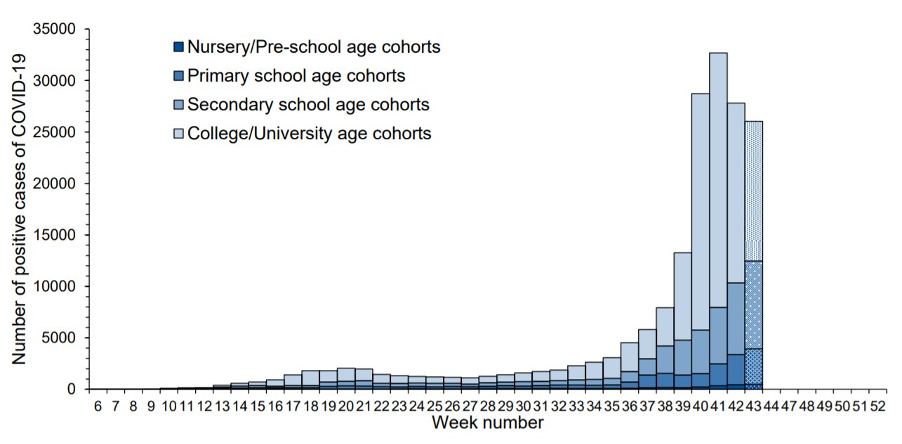
Source: Public Health England, 29-10-2020; week 43 is the week between 19 and 25 October 2020
Also from Public Health England, 29-10-2020:
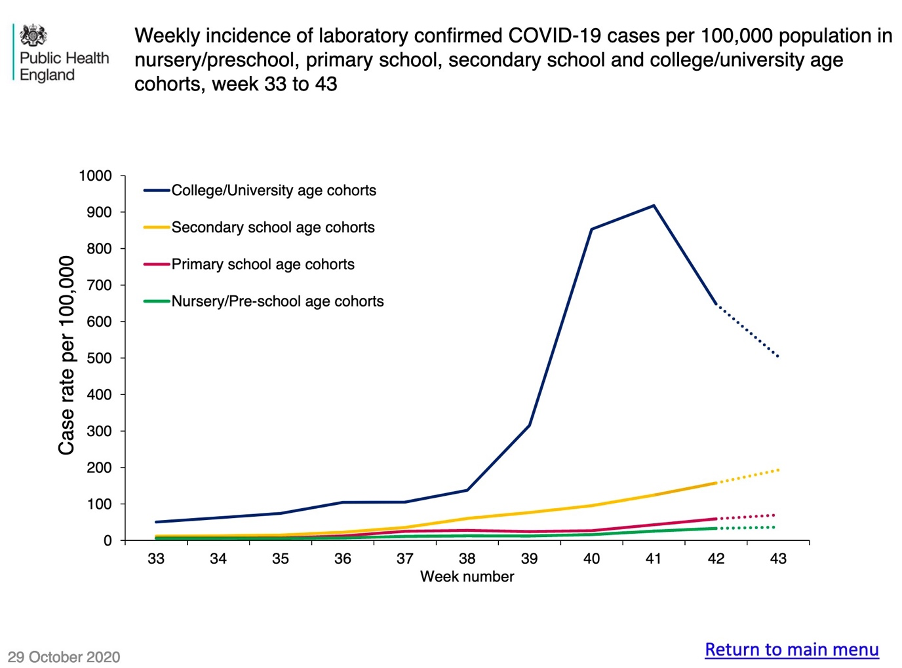
Below, another chart shows the Covid-19 incidence by age group and region, with the age groups between 10 and 19 and between 20 and 29 leading from a distance in all regions between September and October, and with older age groups starting to catch up in all regions after the first week in October (especially in North West and Yorkshire and Humber).
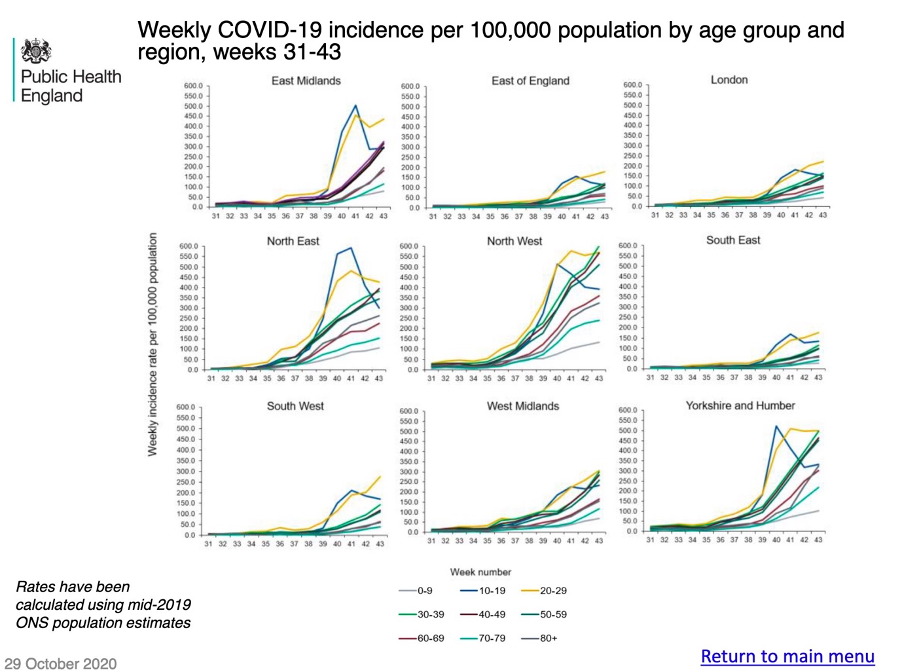
The consequences of universities seeding the virus in their cities and regions are extremely complex and impossible to even consider here. The only effects we have clearly seen so far relate to how universities have seeded the virus in their cities and regions, leading to the overall rise of Covid-19 cases across regions, and to the imposition of three-tier lockdown rules:
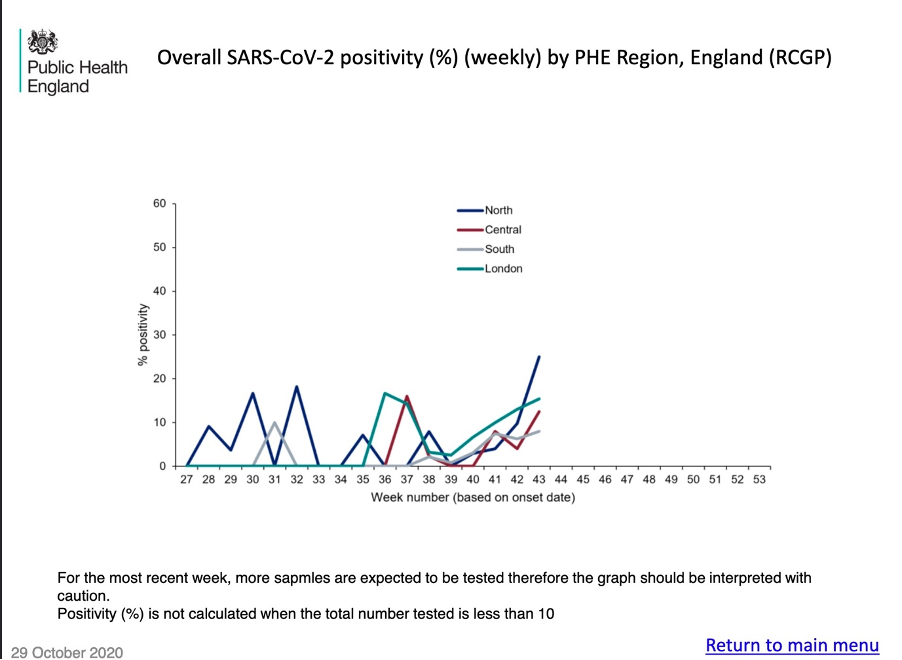
(Source: here)
What we are seeing at this very moment is how more and more counties are being moved to Tiers 2 and 3. The effects of these new type of lockdowns will be severe in many regions, and their cost will not be borne by universities.
However, if universities and the government cannot contain the consequences of these outbreaks through the three-tier system, and most expert advice seems to suggest they will not be able to, then technically the entire country will migrate to tier 3 and then to some kind of national lockdown, once again. A very recent React-1 study from Imperial College has found that “while cases remain highest in northern England, a dramatic increase in infections has been recorded across all areas,” with Covid-19 “prevalence doubling since last month, with the fastest increases in the South where the R number has risen above 2.”
That is basically, the definition of a second wave. A second wave, the universities have been key in causing, together with the government.
What the economic, social and mental health impact of such a second wave will be, it is again, too complex a theme to develop here. How many millions or billions of pounds such a second wave will cost, compared to the savings made by the UK Higher Education sector in these 3 months (or even over the entire year) is a question never posed. Who will be most affected by the economic effects of lockdowns in different regions is another question rarely discussed.
Such are the questions that VCs and Registrars have not engaged prior to September and do not seem to engage now.
However, while all those scenarios are still to unfold and compute in terms of consequences, the direct effects of the September-October reopening of universities on the lives of the people in the surrounding community should be foremost on everyone’s mind. Most of the deaths immediately caused by the virus transmission from the universities, that is, by infections acquired during the peak October outbreaks at the university, will be registered primarily during the month of November. Of concern is that the number of deaths seems to be doubling every week and this rise is not expected to be arrested by the introduction of the three-tier system:
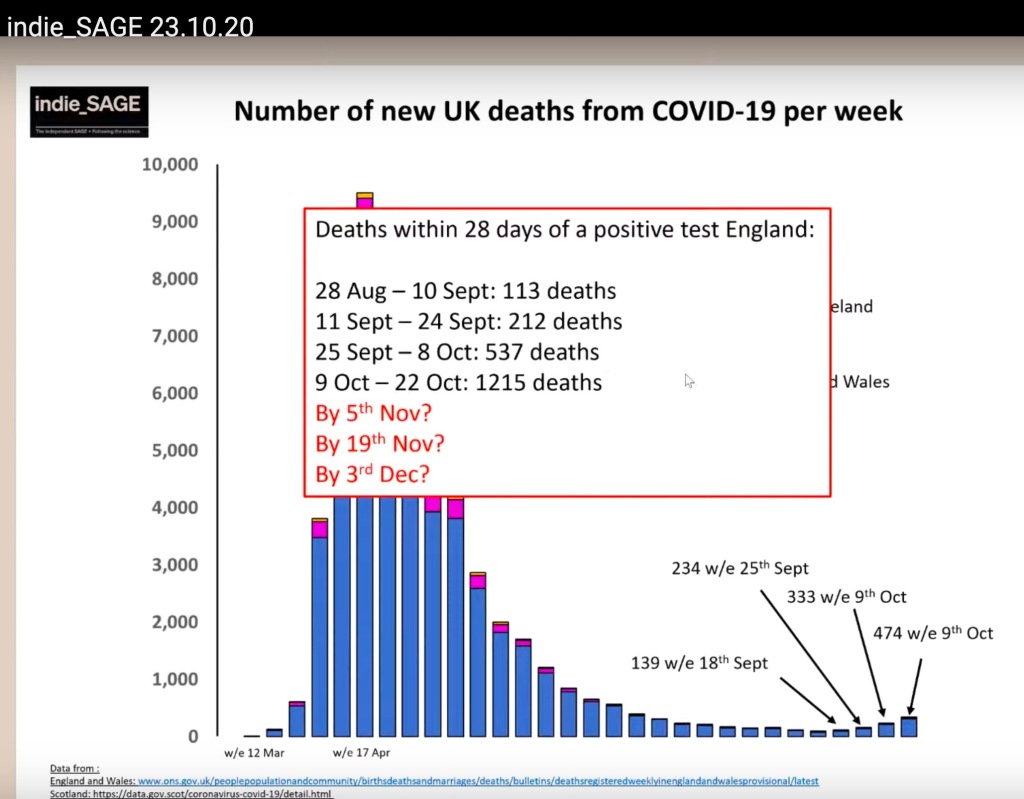
Even if universities and the government manage to contain the outbreaks and transmission from the student population, universities would still be responsible for a second Covid-19 wave that could cause approximately 6.000 or so deaths in the UK in the next month or so.
However, those numbers could be even 8 or 9 times higher, reaching as many as 85.000 deaths over the next three months. And we are not taking into account here the 10-20 % of hospital patients that seem to be developing Long covid. Benjamin Balthaser and Bill V. Mullen suggest that we should recognize in the current series of events a “necropolitical turn,” and this is hard to disagree with:
“Cameroonian philosopher Achille Mbembe revises Foucault’s neologism [“biopolitics”] in his groundbreaking work Necropolitics by positing that the other side of the management of living is the management of dying. In the colonial context, the management of death can appear as refugee camps or extractive and toxic industries such as oil production in the Niger Delta; it can look like death squads, massacres, and gang wars. In the first world, it appears more subtly as lower life expectancies for African Americans and the poor, as the mass detention of migrants, as a thousand or more killings by police each year. Thus, what is shocking about the Daniels [Mitch Daniels – president of Purdue University] and Jenkins [John Jenkins, University of Notre Dame president] statements is not only that they argue for opening their campuses during a pandemic but that they openly accept death as something to be managed, controlled, and even invited.”
That life and death feature massively in the everyday calculations of the bottom line for the university, that biological life is a resource to be exhausted for profit-making, that the lives of students, staff, and faculty can be put at risk for several months of accommodation fees (with those in the bottom jobs being asked to risk their lives first and risk their lives most) only comes to confirm the prolonged deepest fears of the members of the academic community: that themselves and all in the surrounding population of the city, region and nation, particularly those unable to challenge their employers because of fearing for their jobs [as also those having bought in the messaging from big business (universities included) and the government that the virus is not a threat] are expendable.
These were a young colleague’s thoughts in the middle of the month of October:
“I am reminded again that we are expendable to the university. It’s a repeating, bitter lesson for this 28-year old. Makes me really wonder what the future holds for us. We know these are violent and exploitative systems. What do we want our universities to look like? How do we want them to be run? This is not it.”
The thought that the leaders of universities would conceive of the spread of infection beyond the university as a ‘negative externality,’ to use Prof. Otsuka’s earlier phrase, is nothing but chilling (although also chilling is to think of the spread of infection within the university as largely a matter of individual responsibility). Why and how this could happen will remain one of the most important questions to be asked from UK higher education in the years to come. One can only conclude here, like Matthew Cheney has done, that the leadership of universities had already renounced any notions of the public good long before the arrival of the Covid-19 crisis; it is no longer part of how they see themselves or their institutions:
“The actions now taken by university administrations are ones that a cynical person might suspect are taken with glee, because they accelerate the scorched earth strategies begun some time ago: hollowing out of the humanities, hastening the destruction of tenure, marginalizing faculty governance only to areas not considered central to the functioning of the school, promoting the role and power of financial officers within the university hierarchy, etc. The playbook was written long ago. Now it’s set to warp.
While it is infuriating to see all the carnage — it did not have to be like this — the salt in the wound is the failure of leadership to believe in the institution as a public good rather than a customer service. Giving up on the public good is what left us open to evisceration in crisis [my emphasis]. Leaders’ belief in the public good was so flimsy, their hostility to it so open, that it isn’t surprising now when nobody in power even pretends to believe in anything other than the whims of the marketplace. Still, the absolute failure of courage is nauseating. Will no leader in university administration risk their six-figure salary to say, “Our institution is not a business, it is a unique service to the public, one the public benefits from in myriad ways. I will not be complicit in the destruction of that public good.”
No, they won’t say that. Because they can’t, for various reasons new and old. The immediate crisis makes ideals feel like luxuries. The massive obstacles we face are nothing if not overwhelming. Budgets have to get balanced, bills have to get paid. But most of all, leaders won’t say this because they don’t have the words. The complete triumph of the neoliberal attitude has rendered the language of public goods foreign to the lips of power.”
Another National Lockdown, announced on Halloween
Today, on Halloween (the 31st of October), Boris Johnson has made another U-turn and announced a Tier 4 lockdown will be introduced for the entire country on Thursday, the 5th of November. The measure is being introduced in order to prevent 1) the reaching of several thousand deaths per day and 2) a peak of mortality higher than the country saw in April.
This is effectively a national lockdown, but one that, as reported so far, will see schools and universities remain unaffected, although, according to the Guardian: “Neil Ferguson, the Imperial College London professor whose modelling still informs the government, said urgent research was taking place into whether schools and universities could continue to function as at present, given the role teenagers could be playing in the transmission of the virus.” This means that the pressure of SAGE on the government might increase regarding the operation of schools and universities, depending on future research findings.
UCU has already commented that:
Jo Grady, the General Secretary of UCU, has also warned that “A half-measured one month lockdown, with no visible hope of a functioning track and trace system to be delivered at the end of it will not work. They are sowing the seeds of a 2021 lockdown by keeping schools, colleges, and universities open.”
The written guidance later released on the same day by the government specifies the following in relation to universities: “Universities and adult education settings should consider moving to increased levels of online learning where possible.” It remains to be seen how this will translate into action, considering no guidance was given as to what should happen to students in university halls if/when all learning moved online, besides the following advice:
Does that mean that students will not have face-to-face sessions but will still be required to stay in their university accommodation until the end of term? Or, does it mean that the guidance on increasing levels of online learning is not really prescriptive for universities?
It is important to reaffirm here the important advice given by USS Briefs on August 21 regarding face-to-face activites on campus:
“We conclude that this autumn, and for as long as UK prevalence of the virus remains at or near present levels, in the absence of comprehensive and regular testing of all students and staff, UK universities must cancel face-to-face teaching and move instead to an all-online teaching model.
We make an exception for what we call ‘Covid-essential’ teaching — teaching that is essential to the fight against Covid-19 and that can only be carried out face-to-face. In such cases universities should carry out harm-benefit and equality analyses to determine whether the teaching should go ahead and who should be asked to take part in it. Here individual risk assessment tools like those we mentioned at the start can play a role. The same applies for ‘Covid-essential research’. In fact we would argue that an indiscriminate policy of face-to-face teaching is positively harmful to such Covid-essential activities, since it raises the likelihood of an outbreak on campus that will threaten the suspension of virtually all activities.
Although we have focused on teaching, we believe that what we have said here applies to all on-campus work, including IT, library, administration, cleaning and canteen work. The underlying principle should be the same: where on-campus work can be replaced by remote work (as is clearly the case with almost all teaching) then it must be. Where it cannot be, then the decisions as to whether to continue or discontinue it, and if it is continued then who should be asked to undertake it, should be taken strictly on the basis of harm-benefit and equality analyses.” [my emphasis]
The last point highlighted above is crucial. Initially the UK government had based policies regarding people vulnerable to Covid-19 on two categories: “clinically extremely vulnerable” (“at high-risk”) and “clinically vulnerable” (“at moderate risk”). The categories are well explained on this NHS page (also, in this withdrawn guidance from the UK government and on the NI government website). While the government/NHS itself decided who should belong on the first list and issued letters to patients to inform them of their new status, confirming who belonged to the second category was largely left to the discretion of GPs. On the 22nd July, Health-Secretary Matt Hancock informed 2.2 million “clinically extremely vulnerable” people that the shielding support offered to them by the government would end on the 1st of August (Source: here) Previously, that support had consisted of statutory sick pay, government-funded food parcels and medicine deliveries. The UK government justified such measures by claiming that prolonged shielding also has considerable negative effects on clinically extremely vulnerable people (and that these had found shielding measures to be too restrictive).
At the start of term, UK universities informally intepreted this guidance as stating that since ‘the shielding period’ was officially over, all ‘clinically extremely vulnerable’ and ‘clinically vulnerable’ members of staff could now be required to return to campus for face-to-face activities. Not surprisingly, over time this led to increased and continuous frictions with different UCU university branches.
The most recent guidance from the UK government, dating from the 28th of October, has seemingly retained only one category: that of the ‘clinically extremely vulnerable from Covid-19”. For the time being, the government’s advice to people in this category states that “Everyone is currently advised to work from home where possible.”
This should mean that ‘clinically extremely vulnerable’ members of staff should no longer be pressured to return to campus and engage in ‘face-to-face’ activities. However, what will happen to those belonging to the “clinically vulnerable” (“at moderate risk”) category?
Will universities continue to pressure them into returning to campus and engaging in ‘face-to-face’ activities? We observe here that while necropolitics has been previously described as a useful lens for theorizing about the general features of our societies, its specific and practical operations manifest themselves at precisely such levels of university policy-making.
Remarkably, the UK government and UK universities have not previously included in their categories of ‘clinically vulnerable’ people essential criteria relating to ethnicity/race, size of household, or whether households of staff at work also contain ‘clinically extremely vulnerable’ or ‘clinically vulnerable’ people. Not only that UK universities should now expand their guidelines to include such considerations, but they should also update their notions of ‘clinically vulnerable’ people in light of the most recent and comprehensive research available. Policies then, should be enacted to protect such ‘clinically vulnerable’ people, with the choice given to them to not engage in face-to-face campus activities.
In many ways, universities did not keep up-to-date with Covid-19 research developments from the last few months that are of great relevance to their re-opening of campuses. A clear example here is the issue of aerosol transmission, which, if understood properly, would have resulted in very different policies regarding the re-opening of campuses. That expertise, however, is widely available inside universities. When it comes to Covid-19, universities should stop relying on only the government “issued lax guidance” that falls short of “sound public health advice” and embrace their own in-house expertise and that of the local public health institutions. Such expertise should then be practically applied to the local circumstances of their communities, where vulnerability is uniquely positioned.
Where does that leave us going into 2021?
Fundamentally, no plan has been announced to reform the failed Test, Track and Trace scheme.
In addition, a larger part of the population and of the ruling party is less committed to abiding by the government’s regulations regarding Covid-19 than ever before, if not even ready to protest against them. The economy and jobs are also in further decline.
If the origin and primary cause of the second Covid-19 wave, that is, universities, are also set to continue the same way, then a third national lockdown in March is indeed very likely.
A third lockdown in early 2021 also remains likely as long as the current Test, Track and Trace scheme is not comprehensively revised or reformed and the population does not put trust in the government’s guidelines and restrictions. Without a viable test and trace scheme and less adherence to the government’s guidelines, the danger is not only that of facing further lockdowns down the line but that of facing national and local lockdowns that keep getting extended.
Already the government has announced that the current national lockdown “could be extended beyond 2 December.” Entering the new Brexit era in parallel with national and/or local lockdowns is a near certainty now:
<<Former Brexit secretary David Davis said he feared the lockdown would last until the spring, as the virus resurges.
“In March, Boris said let’s hope this will only last four weeks, and it lasted four months. My firm belief this time is it will last six months. Because when it gets to 2 December and R is still 1.5, which it will be, because this lockdown will hold less well than the last one, then it will have to continue.”
He said only countries that have aggressively pursued a “test, trace and isolate” approach, including drastic measures such as closing borders and separating those testing positive from their families in isolation wards, had managed to control it successfully.>>
(Source: here)
To that must be added the possibility of political chaos, social conflict and instability ensuing from the American presidential elections.
The UK government has to find a public health strategy that relies on a functional Test, Track and Trace system and to devise a very complex set of policy plans in all areas of life ensuring Brexit does not bring irreparable harm on an already weakened British state, society, and economy. The focus of the government, however, seems to be elsewhere. The first requires the reform of Test, Track and Trace, but will take at least another 4-6 months. The second is infinitely more complex.
At risk are the economically and clinically vulnerable sectors of society, which would face the brunt of any ensuing crises. There is a possibility that this could well descend into tragedy for many.
With the effects of both Brexit and of the self-inflicted Covid-19 national crisis at their door-step, it is difficult to see how universities across the UK will not be seeking to activate waves of redundancies come December in order to alleviate loses.
Universities have to learn how to identify and fight for the public good in such scenarios of crisis. They must learn to challenge the government on the basis of reason when it fails to see the future consequences of its own actions, or when it tries to centralize power beyond any democratic limits. Narrow financial interests must be challenged in the name of the public good as must be the transfer of public assets into private hands. The general rise of authoritarianism must be resisted. Social media ideological polarization and political propaganda must be deconstructed, exposed and contained with appropriate legislation and with the assertion of a democratic spirit that prioritizes the search for truth, epistemological complexity, and the need for expertise.
Unfortunately, as Ronald Barnett has observed years ago, the university is incapacitated. It has lost its own values, which were those of a life of reason, and is now in a position where it must scrutinize and re-discover itself (Beyond All Reason, p.4):
“Several meanings of universal reason are apparent. Firstly, there is a sense that the criteria of the reason sustained by the university are universal. … Secondly, universities are social institutions that are characteristically open: if any institution in the world approximates to Habermas’s idea of an ‘ideal speech situation’, this is it. Any one of its members can contest any claim by any one of its other members. Provided that decorum is maintained, the first-year student can have a go at the professor. Thirdly, universities are open to allcomers. No-one is to be excluded or admitted on irrelevant grounds, such as financial circumstances, gender, ethnicity or physical capacities. Fourthly, universities are universal in the sense that all forms of valid cognition are open to them: there are no a priori boundaries to the domains of reason that they might pursue. Universities have an interest in ideas as such. Lastly, universities are supposedly places of universal recognition: they are generous spaces in which individuals can expect to have their humanity recognized. [my emphasis]
All these senses of universal reason in the university are now suspect. It is neither clear that the forms of reason upheld by universities can be said to be universal nor clear that universities are characteristically sites of openness and generosity. Consequently, the university – as an embodiment of universal reason – has itself to be suspect.
In a world seemingly short on reason, the university seems condemned by the charge that its contribution to the making of a more rational, open and compassionate world is at an end.” [my emphasis]
Nevertheless, shall we not remain convinced in the power of research and collective action to defend the institution of the university and safeguard its foundational principles?
“Universities in the UK insist on face-to-face teaching, despite the legal challenge from the University and College Union, protests from individual academics, as well as by now overwhelming evidence that there is no way to make classrooms fully ‘Covid-secure’. The justification for this has usually taken the form ‘students expect *some* face-to-face teaching’. This, I believe, means university leadership fears that students (or, more likely, their parents, possibly encouraged by the OfS and/or The Daily Mail) would request tuition fee reimbursements in case all teaching were to shift online. A more coherent interpretation of the stubborn insistence on f2f teaching is that shifting teaching online would mean many students would elect not to live in student accommodation. Student accommodation, in turn, is not only a major source of profit (and employment) for universities, but also for private landlords, businesses, and different kinds of services in cities that happen to have a significant student population.
In essence, then, f2f teaching serves to secure two sources of income, both disproportionately benefitting the propertied class. In this sense, it remains completely irrelevant who teaches face-to-face or, indeed, what is taught.
When I walk into the classroom on Monday, I will want my students to remember that every lecturer stands on the boundary between two worlds, simultaneously dead and alive. Sure, we all hope everyone makes it out of there alive, but that’s not the point: the point is how close to the boundary we get. When I walk into the classroom on Monday, I will remind my students that what they see is not me, but the effigy constructed to obscure the violence of the intersection between academic and financial capital. When I walk into the classroom on Monday, I will want my students to know that the boundary between [the] two worlds is very, very thin, and not only on Halloween.”
(Source: here)
This exercise of recording the present is dedicated to the women that have taken either the government or the leadership of universities (and sometimes both) to task for their failed response over Covid19.
View at Medium.com
LikeLike